Prof. Sir Tejinder Singh Virdee, FRS, Faculty of Natural Sciences, Dept. of Physics, Imperial College, London
Title : “The Long Road to the Higgs boson and Beyond”,
Friday, 11th November 2016, 4.00p.m, in Faculty Hall,
Prof Anurag Kumar, Director, will preside.
====================================================================
Abstract:
The discovery in July 2012 of the Higgs boson at the Large Hadron Collider(LHC) constitutes one of the most important scientific discoveries of this new century. It completes the particle content of the Standard Model (SM) of Particle Physics.
This talk will describe the journey to the discovery of the Higgs boson and look ahead to the LHC programme over the next two decades. Brief details will be given of the design and construction of the ATLAS and CMS experiments. The discovery of the Higgs boson will be describedand selected results from searches for the widely anticipated new physics beyond the SM will be presented.
During the last 25 years, the LHC accelerator, and the LHC experiments at CERN were conceived, designed, constructed and are now operating to tackle some of the most fundamental questions about the origin, the evolution and the composition of our universe. A primary aim was to search for the Higgs boson to reveal the mechanism for generating mass of fundamental particles. Mass is what gives our universe substance. Amongst other questions being addressed are: What constitutes dark matter? Are there extra dimensions of space? Why is the universe composed of matter and not antimatter? The answershave the potential to alter our perception of how Nature operates at the fundamental level.
The LHC restarted operations in spring 2015, atdouble the beam energy of the first run. By the end of this decade the LHC experiments will have examined ten times more proton-proton collisions than done so far, and by mid-2030’s some 100 times more collisions. These data will provide more definitive information about the nature of the found Higgs boson. It is known that the SM is only a low energy manifestation of a more complete theory. Searches will be made for physics beyond the SM in order to illuminate the road ahead to the cherished goal of a unified theory of all physical phenomena in Nature.
Robert Bosch Center Distinguished Lecture Series
Title: Continuum Computing — The Next Step in Theory of Computing,
Speaker: Dr. Narendra Karmarkar, Distinguished Visiting Professor, IIT Mandi and IISc Bangalore,
Date: October 28 2016,
Time: 4-5pm, High Tea after the talk,
Venue: Faculty Hall, IISc
Abstract
One of the goals of any model of computation is to provide basic understanding of various computational problems to enable design of efficient machines and algorithms. The first major successful step in this direction is the concept of Turing machines. However, this model is not adequate for understanding the full power of algorithms that use the concept of the continuum in an essential way, such as the interior point methods, which are highly successful in solving NP-complete problems arising in engineering applications. Various lower bound or inapproximability results in the Turing model do not show any intrinsic limitations of computing but only represent limitations of a particular framework. Careful study of the work of early pioneers Turing, Von Neumann and Godel shows that they were all aware of these limitations. A broader view of theory of computing has therefore become necessary to understand the new algorithms and design of next generation of computers. Advanced continuum based algorithms have applications in many areas of Engineering Optimization, Computational Physics and areas of Computer Science such as Artificial Intelligence.
Our research program in these algorithms has multiple components new mathematical or algorithmic concepts, a software framework aimed at providing an actionable Knowledge Representation System for their implementation, theory and computational experiments.
While Quantum Computing is based different physical principles, continuum computing is based on new mathematical concepts to go beyond current limitations of computing. Unlike quantum computing which loses its advantages if simulated on conventional machines, the continuum computing retains enough of its advantage even in simulation on current machines as an intrim step.
The seminar is aimed at giving a simplified introduction for students interested in undertaking projects in this area.
Biodata: Dr. Karmarkar received his B.Tech in Electrical Engineering from IIT Bombay in 1978, M.S. from the California Institute of Technology[3] and Ph.D. in Computer Science from the University of California, Berkeley in 1983 under the supervision of Richard M. Karp.[4]
He invented a polynomial algorithm for linear programming also known as the interior point method. The algorithm is a cornerstone in the field of Linear Programming. He published his famous result in 1984 while he was working for Bell Laboratories in New Jersey. Karmarkar was a professor at the Tata Institute of Fundamental Research in Mumbai.
Karmarkar has received a number of awards:
- Paris Kanellakis Award, 2000 given by The Association for Computing Machinery for “specific theoretical accomplishments that have had a significant and demonstrable effect on the practice of computing”.
- Srinivasa Ramanujan Birth Centenary Award for 1999, presented by the Prime Minister of India.
- Distinguished Alumnus Award, Indian Institute of Technology, Bombay, 1996
- Distinguished Alumnus Award, Computer Science and Engineering, University of California, Berkeley (1993)
- Fulkerson Prize in Discrete Mathematics given jointly by the American Mathematical Society & Mathematical Programming Society (1988)
- Fellow of Bell Laboratories (1987)
- Texas Instruments Founders’ Prize (1986)
- Marconi International Young Scientist Award (1985)
- American Academy of Achievement award, presented by former U.S. president (1985)
- Frederick W. Lanchester Prize of the Operations Research Society of America for the Best Published Contributions to Operations Research (1984)
- President of India gold medal, I.I.T. Bombay (1978)
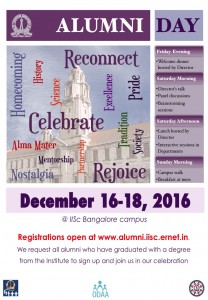
We are excited to announce that IISc’s first annual alumni reunion will be held during December 16-18, 2016. The purpose of this event is to reconnect with alumni at both the Institute and department level. Alumni Day will be held annually every December starting this year. We invite all alumni who have graduated with a degree from the Institute to join us in our celebration.
by Prof. Chennupati Jagadish, Research School of Physics and Engineering, The Australian National University, Title: “Semiconductor Nanowires for Optoelectronics and Energy Applications” on 27th October at 4.00pm in Faculty Hall. [
poster]
Institute Colloquium by Professor C Jayabaskaran, Chairman, Department of Biochemistry.
Title: From genes to Natural Products and Back to Genes: A Journey across two kingdoms
Date and Time: 24th October 4-00 p.m., Venue: Faculty Hall
Abstract: Mankind’s reliance on natural resources for health and disease mitigation has remained an integral part of all human civilizations. Propelled by the confluence of diverse scientific disciplines in addressing a range of human health challenges, currently the study and exploitation of natural products has reignited the worldwide interest of academicians, researchers, industrial houses, policy makers and social scientists alikein the exploration, R&D and conservation of natural resources. The dwindling biodiversity and climate change concerns make it all the more imperative before we lose many species. Plants and fungi are well known sources of bioactive secondary metabolites with potent medical, agricultural and industrial applications. The therapeutically valuable of these secondary metabolites have provided some of the most effective treatment still-date for various human diseases including cancer. Blockbuster anticancer drugs such as Taxol®, vincristine and vinblastine; antibiotics such as penicillins and cephalosporins; the immunosuppressantdrug cyclosporine used in organs transplants and the cholesterol lowering agents known as statins stand aglaring testimony to what has been and what could further be achieved in lowering the human disease burden using natural products or their derivatives.
Long before the present-day fascination with pharmaceutically valuable ‘secondary metabolites’ from plants and ‘endophytic fungi’ – a class of fungi isolated from within plant tissues and cultured in vitro for obtaining bioactive molecules, my research had focussed on the traditional plant molecular biology with tRNAs. In the first half of my talk, I will discuss the work bringing about a transition in my objectives to the applied plant sciences eventually triggering a switch in my passion to the topic of ‘plant and endophytic fungal secondary metabolites’, an area advancing in parallel to the activities in the wider field of metabolic engineering. Several groups have shown the production of identical medicinal compounds by endophytic fungi of certain plants as confirmed by the culturing of individual endophytes followed by purification and characterization of their natural products. In the light of this, our work on some of the FDA approved and novel anticancer, anti-thrombin and other pharmaceutically useful compounds from well known plants and their endophytic fungi will be discussed in the second half of my talk. Towards the end, I will illustrate the problems associated with the low yields of the relevant compounds by target plants/endophytic fungi and various strategies to enhance their production including the application of culture elicitation and optimization, genetic engineering, and the genomics guided platforms –our future goals.
A five day workshop on Brain, Computation, and Learning will be held during January 9-13, 2017 in the Faculty Hall, IISc. Details will be available soon.
UGC Refresher Course Equivalent Training programme for College Teachers teaching BSc Physics, Chemistry, Maths and Biology from Nov 23 to Dec 13 (21 days) program at IISc in its new Campus.” New Opportunity for College Teachers to learn Science by doing experiments. Brochures:
Physics,
Chemistry,
Mathematics,
Biology. For more details please visit:
tdc.iisc.ac.in
for Innovative Thinkers, Creative Designers, Hands-on Makers & Engineers Doctors and other Healthcare Professionals during 3-6th Nov 2016 at Centre for Product Design and Manufacturing (CPDM), IISc, Bangalore [
Poster]
Click here for more information.
The Pratiksha Trust has endowed three visiting chairs in Neurocomputing and Data Science. The first of these chairs, Shri. K. Vaidyanathan Chair, is held by Professor Shihab Shamma, University of Maryland. Professor Vasant Honavar from PennState will hold the Mrs. Sudha Murthy, the second chair position. An event to announce the Mrs. Sudha Murthy Chair position is scheduled at 3.30 PM on Wednesday October 12th in the Faculty Hall in the IISc Campus.
PSN _Memorial_Lecture_2016, by T. Padmanabhan Distinguished Professor IUCAA, Pune, India. on Thursday, 13 Oct. 2016, 16:00 hrs @ Physical Sciences Auditorium
“Toward Data-Driven Education”[poster]
BY
Dr. Rakesh Agrawal President,
Data Insights Laboratories, USA
Smt. Rukmini Gopalakrishnachar Visiting Chair, CSA
Date and Time: Wednesday, September 28, 2016, 4:00 PM
Venue: Faculty Hall, Indian Institute of Science
Abstract A program of study can be viewed as a knowledge graph consisting of learning units and relationships between them. Such a knowledge graph provides the core data structure for organizing and navigating learning experiences. We address three issues in this talk. First, how can we synthesize the knowledge graph, given a set of concepts to be covered in the study program. Next, how can we use data mining to identify and correct deficiencies in a knowledge graph. Finally, how can we use data mining to form study groups with the goal of maximizing overall learning. We conclude by pointing out some open research problems.
Speaker Biography: Rakesh Agrawal is the President and Founder of the Data Insights Laboratories. He is a member of the U.S. as well as the Indian National Academy of Engineering, a Fellow of ACM, and a Fellow of IEEE. He has been both an IBM Fellow and a Microsoft Fellow. ACM SIGKDD awarded him its inaugural Innovations Award and ACM SIGMOD the Edgar F. Codd Award. He was named to the Scientific American’s First list of top 50 Scientists. Rakesh has been granted 80+ patents and published 200+ papers, including the 1st and 2nd highest cited in databases and data mining. Four of his papers have received “test-of-time” awards. His research formed the nucleus of IBM Intelligent Miner that led the creation of data mining as a new software category. Besides Intelligent Miner, several other commercial products incorporate his work, including IBM DB2 and WebSphere and Microsoft Bing.
IISconnect: Industry Interaction Day (3rd October 2016)
Special Lecture by Prof Sir Leszek Borysiewicz, Vice Chancellor, University of Cambridge on “Global collaboration in the face of Global challenges” Friday, September 16, 2016 at 3.30 pm in the Faculty Hall.
Abstract: How do universities and research institutes contribute to society at a time of increasingly complex and global challenges? In his keynote address at the IISc, the Vice-Chancellor of the University of Cambridge will address the importance of international collaboration in the development of science and research, and the role of university partnerships in tackling some of the most pressing global problems.
(click on the poster below for enlarged version)
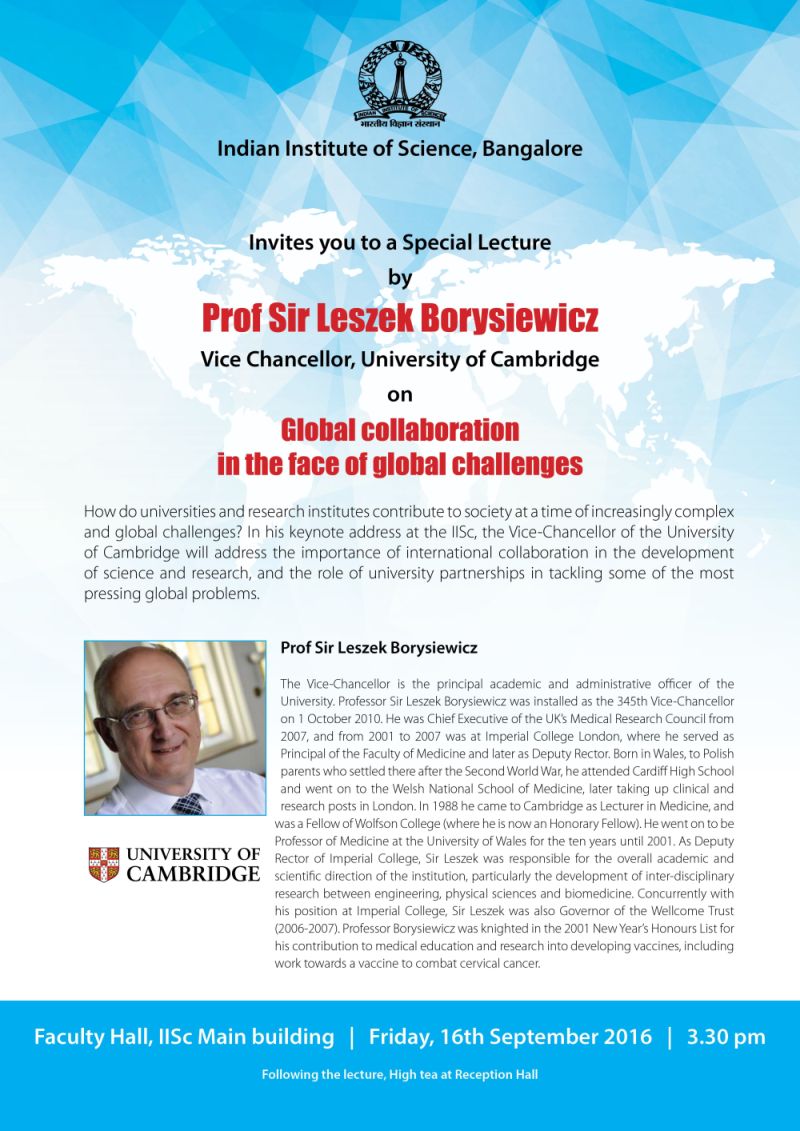
Climate Science Quiz 2016
J Srinivasan*
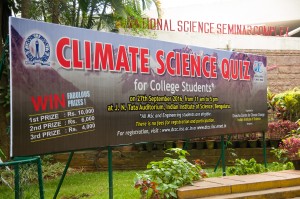
The Divecha Center for Climate Change organized the 8th Climate Science Quiz for students of engineering and MSc on Tuesday 27th September 2016 at the J. N. Tata Auditorium, Indian Institute of Science. For details see: http://dccc.iisc.ac.in/
Sir Vithal N Chandavarkar Memorial Lecture by M. J. Akbar, Honourable Minister of State for External Affairs and Member of Parliament, Rajya Sabha.
Title: “The Geopolitics of India and Asia: Challenge and Opportunity”
Date : Friday, 9th September 2016, Venue: Faculty Hall. Time : 3.00p.m.
Prof. Anurag Kumar, Director will preside.
“Force Modernization Requirements of the Indian Army – Opportunities for Start-ups, MSMEs and Niche Technology Players” by Lt. Gen. Subrata Saha, UYSM, YSM, VSM, Deputy Chief of the Army Staff (P&S) Indian Army, followed by an Interactive Session moderated by Prof. Vikram Jayaram Chair, Division of Mechanical Sciences, IISc.
Venue : Faculty Hall, IISc, Date : 02 Sep 2016, Time : 2.30 pm.
Establishment of “Future Earth” South Asia Regional Hub
Gaurav Govardhan*
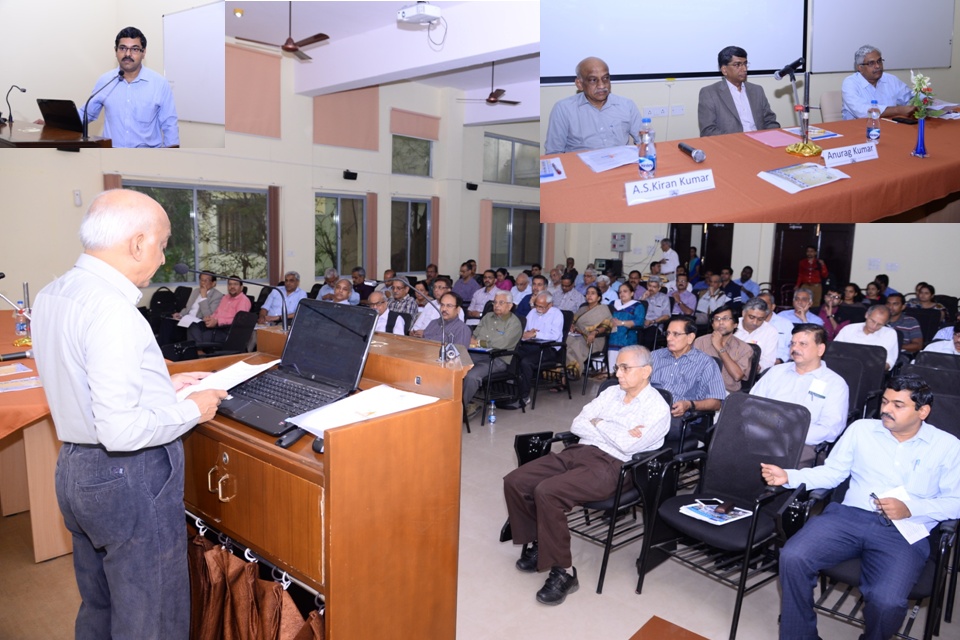
AS Kiran Kumar, Secretary, Department of Space, and Chairman, ISRO, addressing scientists during the inaugural session of the ‘Future Earth’ meeting. Inset, left: SK Satheesh, Chairman, Divecha Centre for Climate Change. Inset, right: AS Kiran Kumar, Anurag Kumar (Director, IISc), and M Rajeevan (Secretary, Ministry of Earth Sciences). (Courtesy: The Divecha Centre for Climate Change)
The South Asia regional hub of Future Earth, an international programme on global environmental change and sustainability supported by agencies including UNESCO and the United Nations Environment Programme, will be set up at the Divecha Centre for Climate Change, IISc. This was announced at an event held at the Centre on 9 July 2016.
Future Earth, which brings under its fold many existing international programmes including the International Geosphere Biosphere Programme and the World Climate Research Programme, has five global hubs, or secretariats, that are located in Canada, France, Japan, Sweden and the United States. These secretariats are complemented by regional hubs spread across the globe. The regional hub for South Asia will now be established at the Divecha Centre. “The South Asia regional hub,” SK Satheesh, Chairperson of the Divecha Centre, said, “is an autonomous research platform that promotes scientific cooperation between India and neighbouring countries in Future Earth related activities. The regional hub will ensure that regional priorities are made part of the strategic development of Future Earth activities.”
“The vision of Future Earth is ‘Science for the People’ and requires solutions-oriented research that responds to the challenges faced by the society due to global environmental change in collaboration with various research partners, decision-makers in government, the private sector and civil society,” he added. In accordance with this spirit, the event was attended by more than 70 scientists from various government organizations, national laboratories and academic institutions, including Anurag Kumar, Director, IISc and AS Kiran Kumar, Secretary, Department of Space and Chairman, ISRO, and M Rajeevan, Secretary, Ministry of Earth Sciences.
The brainstorming session during the meeting saw discussions on some tentative selected topics which are relevant to the South Asian region, such as the impacts of climate change on the monsoon, extreme weather, water security, food security, air quality, and renewable energy. The regional hub will soon organize its first workshop to take this forward. “Thematic working groups, or task teams, will be established soon after this workshop,” said Satheesh. “The mandate of this hub/office is to integrate the available information and develop strategic knowledge and region-specific strategies to tackle and face consequences of climate change,” he added.
*Gaurav Govardhan is a PhD student at the Centre for Atmospheric and Oceanic Sciences and the Divecha Centre for Climate Change.
Summer School on Internet of Things
Shishir G. Patil*
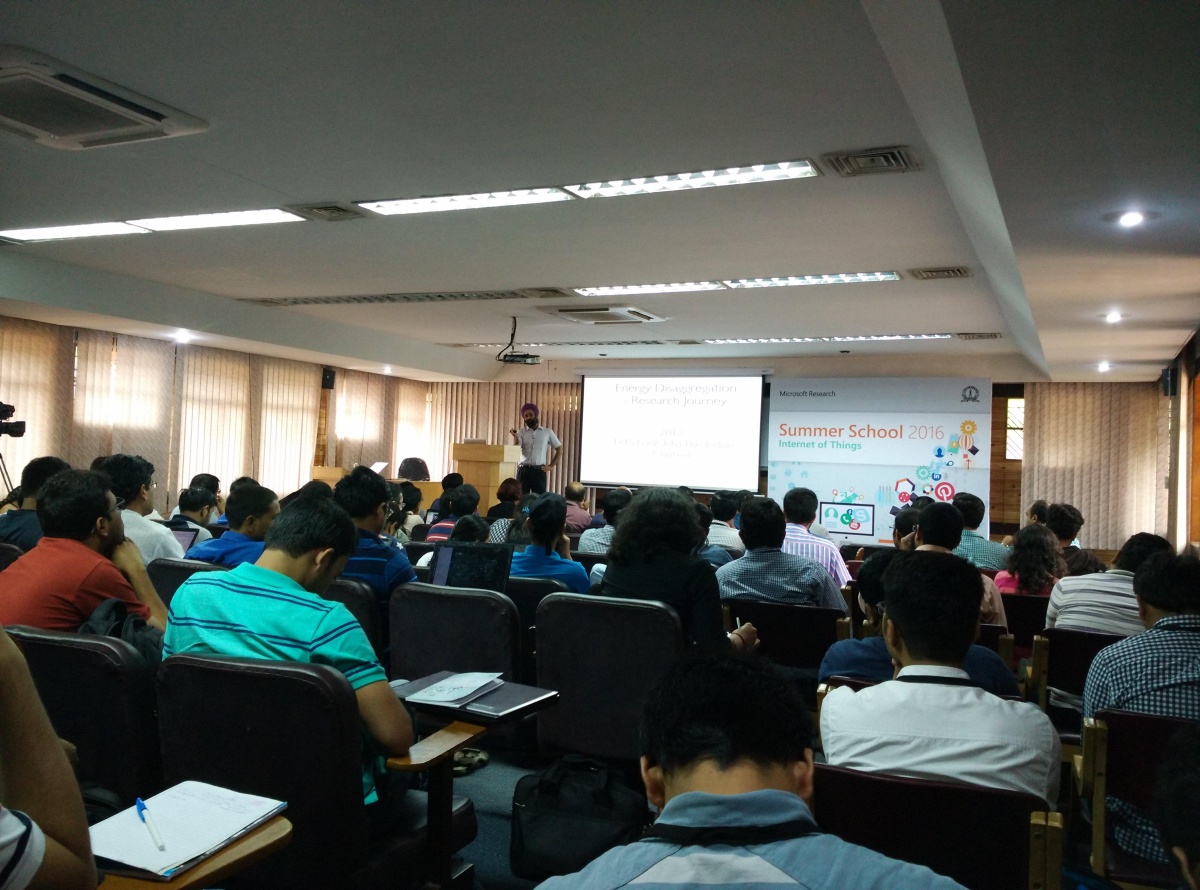
Amarjeet Singh, Chief Technology Officer, Zenatix, addressing the participants at the Summer School (Courtesy: Microsoft India)
A summer school on Internet of Things (IoT) was conducted by Microsoft Research India (MSR India) in collaboration with the Department of Computational and Data Sciences (CDS) at IISc from 20–25 June, 2016. The participants were students invited from academic institutions across the country.
This summer school was part of an annual series which aims to provide an opportunity for students to learn the fundamentals of a subject as well as state-of-the-art research. This year’s theme, IoT, refers to the networking of physical objects through the use of embedded sensors, actuators, and other devices that can collect and transmit information about the environment around them. The data collected from these devices can then be used to deliver various products and services. Analysts estimate that by 2020, we are likely to have about 30 to 50 billion connected devices globally. In India, the potential for IoT devices is enormous. These devices are expected to be used in applications ranging from air-quality monitoring to traffic management.
There were three invited talks each day followed by a lab session/tutorial/panel discussion, during which students interacted with the resource persons. The talks were on diverse topics, and began with an introduction to the topic, leading to a discussion on problems open to research. Ronak Sutaria, an independent researcher in Mumbai, spoke about his work on developing low-cost, efficient devices for monitoring the quality of air. In an intense mathematical session featuring cutting-edge research, Ashish Kapoor (MSR) introduced the students to mathematical modeling and analysis of wind flow data from multiple points on aircrafts (called swarm sensing) to optimize flight routes. Ranveer Chandra (MSR) shared his research on enabling IoT devices in farms to collect data on nutrients and moisture content in the soil. KVS Hari (ECE, IISc) demonstrated how cars could be identified based on their electromagnetic signatures, one small puzzle on the road to the development of self-driving cars. Other speakers included Zainul Charbiwala (Tricog Health), Marco Gruteser (Rutgers University), and Shaz Qadeer (MSR).
The last day of the summer school saw a “hackathon”, in which the students, divided into teams, had to come up with solutions to technological problems using kits of Raspberry-Pi, Arduino, elemental sensors and Azure cloud offerings. The event culminated with demonstrations of the projects by the respective teams. The winning team built a working model for indoor security that displays, in a smartphone app in real-time, information from sensors installed in a home. Efforts by other teams included a smart transportation system which can send alerts about road condition, parking availability and vehicle location to drivers and emergency responders, and a smart refrigerator which can send alerts when it’s time to refill its stock of vegetables and fruits. All the code and documentation from the hackathon was made available online for the benefit to the broader community.
Speaking to CONNECT, Yogesh Simmhan, one of the organizers of the summer school, said, “The summer school provides an opportunity for students to get exposed to cutting-edge research at global standards. It also helps participating students from across the country to learn more about current research and opportunities at IISc.”
*Shishir G. Patil is a Research Intern at the Centre for Nano Science and Engineering
ICMR 2016
Punit Kumar*, Gyan Shankar*, Sweety Arora*
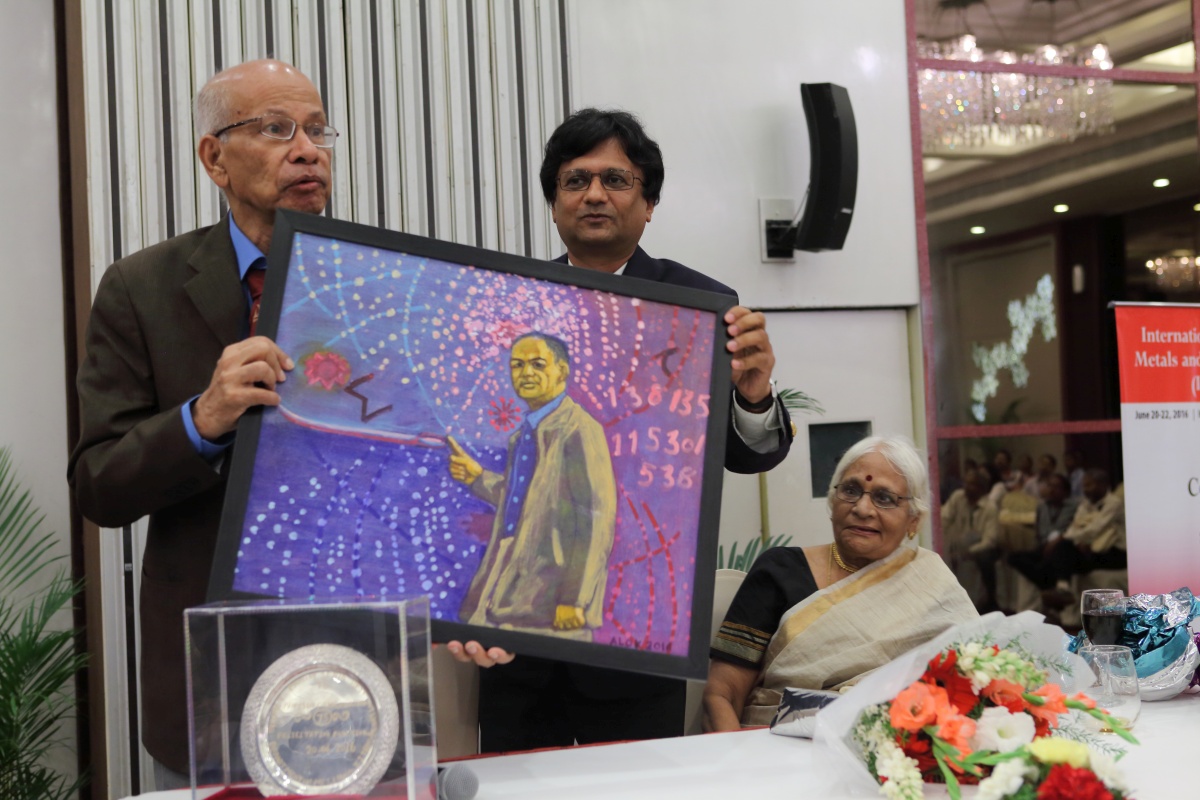
Alok Singh presenting his painting of S Ranganathan (Credit: Organizing Committee, ICMR 2016)
An International Conference on Metals and Materials Research (ICMR) was organized in honour of S Ranganathan, an emeritus professor in the Department of Materials Engineering, on the occasion of his 75th birthday on 20 June 2016. ICMR, held during 20–22 June 2016, was hosted by the Department in association with the Bangalore chapter of the Indian Institute of Metals.
The conference saw many luminaries from the field discuss the latest innovations in materials technology. The ball was set rolling by one of India’s most well-known chemists, CNR Rao (JNCASR, Bangalore) who inaugurated the conference. He spoke about 2D inorganic materials and 2D single-layer materials which could have electronic properties similar to graphene, such as molybdenum sulphide (MoS2), gallium sulphide (GaS), gallium selenide (GaSe) and a form of boron cyanide (BCN). In his address, he also urged materials scientists in India to develop new materials that we could call “our own”.
Two of Ranganathan’s former students, BS Murty (IIT Madras) and VS Raja (IIT Bombay), along with Satyam Suwas (Materials Engineering, IISc), co-chaired the conference. In the first plenary session, AL Greer (University of Cambridge, UK) analyzed processes that are presently popular for improving the mechanical behaviour of amorphous forms of metals known as bulk metallic glasses. Barry Carter (University of Connecticut, USA) discussed how the development of latest characterization techniques had changed the way researchers look at materials. K Chattopadhyay (Chairperson, Interdisciplinary Centre for Energy Research, IISc) addressed the challenges associated with the development of new alloys. He highlighted the progress made by his research group in the development of new series of cobalt-based superalloys. These low-cost superalloys could improve the efficiency of energy generation in thermal power plants and of chemical processes in oil refineries.
In parallel technical sessions, U Kamachi Mudali (IGCAR, Kalpakkam) shed light about the indigenously developed high-nitrogen stainless steel for use in nuclear power plants. SV Kamat (DMRL, Hyderabad) spoke about futuristic materials which could potentially find applications in defense. Pradip P (TCS, Pune) presented a state-of-the-art Integrated Computational Materials Engineering platform for fabrication of engineering materials and products, developed by TCS. The first day of the conference ended with a felicitation program in honour of Ranganathan, whose work in materials research spans more than half a century.
In the second plenary session of the conference, A Inoue (Tohoku University, Japan) showed how a small geared motor, with a diameter of 1.5 mm, was fabricated using metastable amorphous alloys. S Banerjee (BARC, Mumbai) revealed how laser-processed cast iron skillets could be utilized for oil-less cooking. BS Murty explained the challenges associated with the fabrication of high-entropy alloys. Satyam Suwas talked about grain boundaries engineering, a novel way for material processing. Using this method, the ductility of metals can be improved without much reduction in their strength. Dheepa Srinivasan (GE, Bangalore) explained the potential of modern technology “additive manufacturing” as the future of repair technology. Shardha Srinivasan (NIAS, Bangalore) took the audience back in time by highlighting the efforts to bring to light the glorious history of metallurgy in India through the archeological findings of Iron Age high-tin bronzes from Tamil Nadu.
*Punit, Gyan, and Sweety are PhD students in the Department of Materials Engineering
The President of India will be addressing the students and faculty members of the higher learning institutions & probationary officers in civil service academies through Video Conference using NKN on 10th August, 2016 at 1230 hrs”.
Venue: SERC-Auditorium (4th Floor)
THE TENTH BIENNIAL LAKE CONFERENCE-LAKE 2016 : Conference on Conservation and Sustainable Management of Ecologically Sensitive Regions in Western Ghats (28 -30 December 2016)
Internet based Course: Environmental Management (XIV Session – September 2016)
Address by Dr. R. Chidambaram
Annual Convocation of the Indian Institute of Science, Bangalore
25th June, 2016
Introduction
It is a privilege to give the Convocation Address of this famous institution, where I was a student many decades back and spent some of the happiest years of my life.
I have been very fortunate in spending all of my professional life in two of India’s greatest institutions―the Indian Institute of Science and the Bhabha Atomic Research Centre. Incidentally, Homi Bhabha’s conceptualization of our nuclear energy programme happened when he was in the Physics Department of the Indian Institute of Science.
I joined the Institute in 1956, after passing out in Physics Honours from the Presidency College, Madras, from where C.V. Raman and S. Chandrasekhar had also passed out many decades earlier. At that time, metallurgy was very much in the air―new steel plants were being set up in the country. Though my interest had always been in physics, I suddenly got attracted to metallurgy and applied for admission to the D.I.I.Sc course in the Department of Metallurgy. But Prof. R.S. Krishnan, the then Head of the Department of Physics, decided that I will be joining the Department of Physics, not Metallurgy! That was an important turn in my career.
In those days, the Institute was not giving the kind of degrees it does now, after becoming part of the university system. M.I.I.Sc, instead of a Ph.D., was not a very attractive proposition and most of the research students registered themselves for their Ph.D. degrees in the universities they came from, all of which the Institute had the necessary arrangements with. This changed when I was a student here and I did get a Ph.D. degree from the Institute. The D.Sc. degree came later when Prof. C.N.R. Rao was the Director.
When I joined the Institute, Prof. R.S. Krishnan told me that I will be working with Dr. G. Suryan. “He is a man full of ideas”, Prof. Krishnan added. And indeed he was! Dr. Suryan wrote his first paper on acoustics when he was thirteen years old. He was the first person in India to observe the phenomenon of Nuclear Magnetic Resonance (NMR). The flowing liquid method he developed in the Institute to bypass the saturation of NMR signals, caused by long spin-lattice relaxation times, was a brilliant idea and was widely cited internationally. My Ph.D problem involved building a wide-line NMR spectrometer. Dr. Suryan’s exceptional knowledge about materials and techniques was valuable in building this kind of spectrometer for the first time in the country and it worked very well for a couple of decades, even much after I had left the Institute in 1962 to join the Bhabha Atomic Research Centre.
The seed of my continued interest in indigenizing advanced instruments can be traced back to my early years with Dr. Suryan. Earlier, for my M.Sc degree, I had worked with Dr. Suryan on the design of a magnetic storage system for the Fourier Synthesizer CHITRALEKHA he was building for use by x-ray crystallographers. In the 25th April, 2016 issue of Current Science, there is an excellent article on Dr. Suryan, entitled ‘Make in India: Lessons from G. Suryan’s NMR Research’. Unfortunately the value system of our Science Academies does not sometimes allow them to recognize such pioneering work, though INSA has very recently taken the first corrective step.
The Institute research scholarship in those days was Rs. 56 per month, and my expenses had to be supplemented by receipts from my father. From the second year onwards, I started getting the Junior Fellowship of Rs. 250 per month, a princely sum in those days, from the Department of Atomic Energy. After some time, this became a Senior Fellowship of Rs. 400 per month.
Role of the Institute
The IISc Alumni Meet in Santa Clara, USA, in 2006 was a great pioneering event. It is a surprise that it had not happened earlier because the Pan-IIT Alumni Meet had been going on for a long time. The Santa Clara meeting was a huge success and I am happy to learn that the links with the alumni are getting stronger.
I also had the pleasure of participating in the Global IISc Alumini meet in Chicago in July 2013. And there, Prof. Rudra Pratap, who heads the Centre of Nano Science & Engineering here, told the alumni from US that his facilities in CENSE were better than theirs, and the NRI alumni scientists did not disagree. The self-confidence in the Institute thus remains undiminished.
The IT services sector has undoubtedly created a great deal of wealth for the country and, I am sure, will continue to do so. And that is welcome. But I also want India to have IT software products which dominate the world. In the so-called C.K. Prahlad Pyramid, I want India to be at the top of the Pyramid, including in hi-tech manufacturing, and it is the responsibility of IISc to help prepare the path for India to reach there, for India to become a ‘developed country’ and a ‘knowledge economy’, apart from retaining its leadership in basic research.
More generally, I think experts in S&T should not give emphatic opinions on fields outside their own specializations, particularly if they are influential and respected leaders in their own fields.
IISc is the top-ranked university in India and made an entry last year in the world’s top 100 Universities in the ‘Times Higher Education Ranking for Engineering and Technology’. CENSE is one of the many examples of centres of excellence in interdisciplinary research in the Institute, with some of the leading scientists in India guiding them. There are others like the Centre for Atmosphere Sciences and the Divecha Centre for Climate Change (led by Prof. J. Srinivasan) and the Centre for Neuroscience (led by Prof. Vijayalakshmi Ravindranath until recently), though the inter-disciplinary nature of the latter Centre is not obvious from its name! There are many others. These centres are very important because boundaries between disciplines are becoming more and more fuzzy. Of course, excellent work goes on here in departments doing pure sciences like Physics. I am also very happy that more and more IISc scientists are writing authoritative books on specialized topics―for example, the excellent book on ‘Game Theory & Mechanism Design’ by Prof. Y. Narahari; I benefited greatly by reading the book.
Ecosystem in the Institute
The purpose of a university is to provide a liberal education, imbibe in the students a respect for other cultures, to create the environment to help advance global knowledge, to help create a ‘knowledge economy’ in the country, to provide students with the necessary knowledge and skills for jobs in an ambience of rapidly growing knowledge and continuously emerging new technologies, and to provide training in super-specialized fields.
We need an excellent ecosystem for higher education and research in our universities, whose components are: talented young students, high quality faculty, adequate funds, sound infrastructure, including an e-science infrastructure (the research and education network, our National Knowledge Network (NKN), established by the National Informatics Centre, fulfills this role), strong academia-industry interactions, appetite for risk-taking in academia, industry and the government, international collaboration (to be leveraged to strengthen indigenous efforts), using best emerging technologies in higher education and world-class research facilities. Such an excellent ecosystem for science and technology exists in the Institute.
IISc already has strong linkages with industry―SID (Society for Innovation and Design) has played a very important role in strengthening the Institutes linkages with Indian and global industry. This has so far generally involved participating in proprietary product or process development and related applied research for individual companies. Research involves acquiring new knowledge and innovation in the context of S&T, and must add economic value or societal benefit or strategic value. We must look at all aspects of innovation―product, process and design―as we try to become a global innovation leader. Our office had organized a brainstorming session on ‘Hi-tech Manufacturing Startups’, in which Dr. B. Gurumoorthy had also participated. I am very happy that the Centre for Product Design and Manufacturing in the Division of Mechanical Engineering is planning a series of workshops across the country in this context.
Achieving the goal of a ‘developed’ country and ‘a knowledge economy’ is not easy for an economically-developing country like India. In an already-developed country, there is a thermodynamic equilibrium between knowledge in the academic system and the knowledge in the industry system. That is why industry is waiting for new knowledge to come out of the academic system and is also funding this process. Such an equilibrium does not exist yet in all technology sectors in India and industry then is satisfied with ‘technology transfer’. But India is changing, and changing rapidly. The closer a technology sector comes to be globally competitive, the greater is its desire to interact with the academic system. This is beginning to happen and the academic system, particularly IISc, must be prepared for this transformation.
I have been saying for many years that haemorrhage of research talent is taking place at two points―for pure science after the 10+2 stage and at B.Tech level for engineering. There is need to induct them into research careers and to retain them there. IISERs and CBS (Mumbai University and DAE), with their five-year M.Sc courses, the INSPIRE programme of DST, etc. are all attempts at addressing this issue. I am very happy that IISc, giving high-quality undergraduate courses in science (the curriculum, I note, also includes engineering and humanities) in a world-class research ambience, with most of the B.S. students hopefully going on to doing an M.Sc or Ph.D. It is providing a platform for them to have excellent careers in science. I notice this is the second batch of undergraduate students getting their degrees.
A Knowledge-driven Economy
Education is a recurring theme in the speeches and writings of Swami Vivekananda, who was a unique bridge between India’s spiritual heritage and the then emerging modern India. Swami Vivekananda’s views “on the growth of ascetic spirit in India” and “diverting it to useful channels” shared with J.N. Tata during a ship journey in 1893, apparently influenced the latter in the setting up the Indian Institute of Science in Bangalore. Swami Vivekananda has said: “Knowledge itself is the highest reward of Knowledge, and secondly there is also Utility in it.”
A knowledge-driven economy should have the ability to develop new knowledge and the ability to appropriate knowledge developed in other countries. Excellence is needed in higher education and basic research (including what I have called ‘directed basic research’), in applied research, in R&D-led technology development and in innovation, backed by high-quality manufacturing.
Basic research is a cultural necessity in any civilized country. The highest intellects in a country must be allowed to work on fundamental research problems of their choice. India is trying to build an advanced technology superstructure, but also realizes that this needs a strong foundation of basic research.
In research, it is good to follow the advice to young scientists by the famous biologist Peter Medawar (also valid, by the way, for older scientists): “Always work on important problems―important to science or important to society”. A young scientist must, of course, worry about publications, impact factors of the journals he or she is publishing in, and so on. But as you grow older and have got established, you begin to worry less about number of publications, h-index and so on, and worry more about what difference your work is making for the country, and the scientific world.
Concluding Remarks
IISc is a great academic institution and there is no doubt that it will continue to be so and play a crucial role in India’s future development.
Thank you and Jai Hind.
» View Bio of Dr. R. Chidambaram (pdf)
On Being a Mathematician in the Industry
Nithyanand Rao*
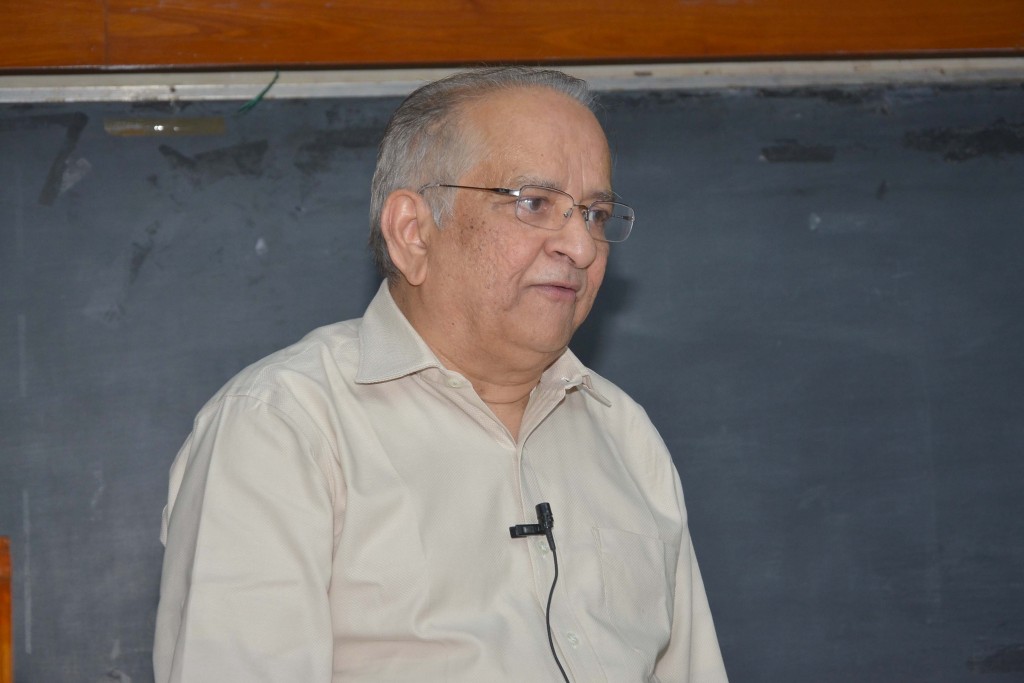
(Courtesy: IISc Public Relations Office)
V Ramaswami, Vice President of Strategy and Research at Color EyeQ, Inc., USA, gave an Institute Lecture titled The Grass on the Other Side―How is it being a mathematician in the industry? on 16 May 2016 at IISc.
Introducing the speaker, IISc’s Director Anurag Kumar, who was Ramaswami’s colleague at Bell Labs in the 1980s, said that Ramaswami had made important contributions to queuing theory by developing algorithms that could be applied to real-world problems.
According to Ramaswami, for an applied mathematician employed in industry, research is about problem solving, which, he said, begins with applying common sense. One of the examples he gave was a problem he worked on while he was at AT&T Labs. People using the company’s telephone services complained that they couldn’t at times make calls, often emergency ones, because there was no dial tone when they picked up their phone receivers. Based on data collected from maintenance operations and the call logs, combined with knowledge of the telephone network’s topology, he suspected that dialup internet calls were to blame for the congestion. These internet calls typically last much longer than the usual telephone calls, preventing other users from accessing the services. However, engineers from the company were dismissive, saying that dialup calls couldn’t be responsible since they only formed about 8% of all calls.
But Ramaswami pressed on, observing that this issue appeared to arise only in the late evenings, after business hours. Moreover, had faulty equipment been responsible there would have been a spatial pattern to the customer complaints; this was not the case. He then plotted the distribution of call-length times, and found a long-tailed distribution rather than the expected exponential distribution. This meant that there were a small number of calls that were of much longer duration than most other calls―these were causing congestion in the network. “Maybe there were many kids who were downloading videos,” Ramaswami joked.
He was then able to validate his model using data. Instead of plotting the call-length durations, he decided to plot what’s called the residual distribution. This is the distribution obtained if one does not measure entire call-lengths, but instead enters at a random instant and then measures the remaining time of the call. Because the dialup calls were longer, they appear more prominently in this residual distribution. The solution he proposed was to keep a check on the number of simultaneous users making dialup internet calls. The results that Ramaswami and his colleagues obtained from this work now have applications in call centre engineering as well as in network security.
Reflecting on his career as a mathematician in industry, Ramaswami said that it is important to have the knack of focusing on the essential aspects of a problem. Any solution one comes up with cannot just be theoretical―it has to be implementable. And then one has to explain it and convince the people who will be implementing it. “You have to respect others’ specialisations and responsibilities,” he said. “I had trouble convincing even fellow mathematicians, what to say of field engineers who have to implement it?”
He also argued that the general perception that applied work is not challenging is not true. Comparing it with research in academia, he felt that, in industry, one gets to learn continuously by being confronted with new and challenging problems that have immediate real-world applications. “So you can see your research come alive,” he observed. On the other hand, in academia, one has the freedom to choose what problems to work on. He said that in industry, where one is responsible for the company’s clients, “you can’t run away from hard problems.”
*Nithyanand Rao is a Consultant Editor at the Archives and Publications Cell
EECS Research Students Symposium 2016
By Cressida Hamlet and Prateeksha Varshney*
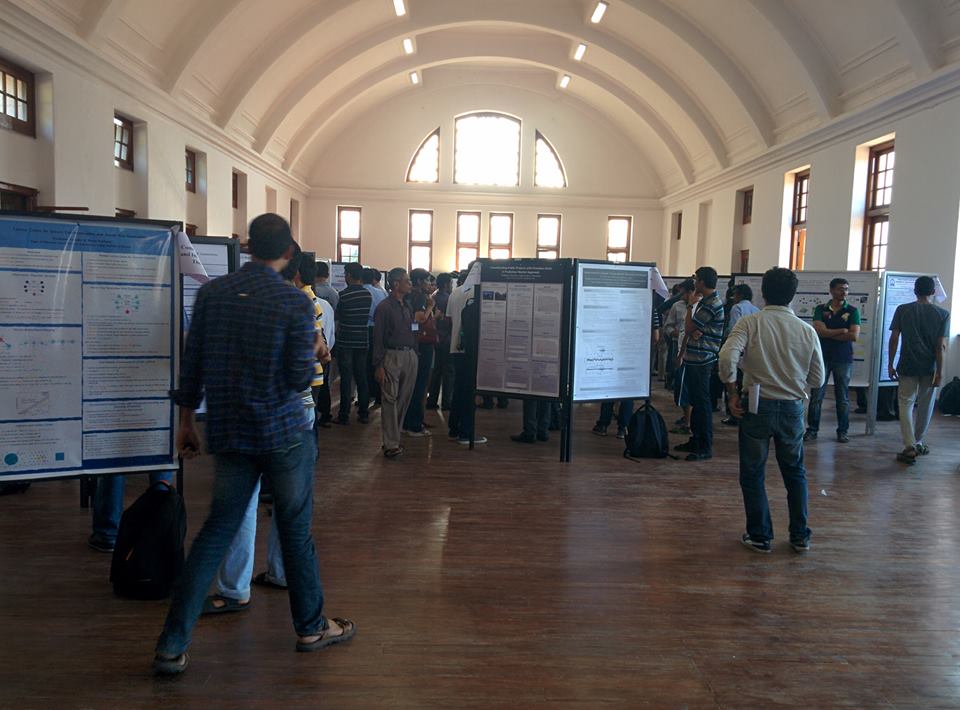
The poster session held during the EECS Symposium 2016 (Arijit Mondal and Harikiran)
The 7th Joint EECS Research Students Symposium was held on 28 and 29 April 2016 at IISc. Participating in the symposium were the Departments of Computational and Data Sciences (CDS), Computer Science and Automation (CSA), Electrical Communication Engineering (ECE), Electrical Engineering (EE), and Electronic Systems Engineering (ESE).
“The primary focus of the EECS symposium is to showcase the research work of final year students from these five departments,” Dipanjan Gope, one of the members of the organizing committee from ECE, told CONNECT. Over 50 students, from both PhD and Master’s programmes, made oral and poster presentations of their research work. The event, sponsored by GE, Bosch, and Flipkart, also provided a platform for the industry to sample the research at IISc.
The symposium featured four keynote talks by speakers from outside IISc. Pramod Varma, Chief Architect and Technology Advisor, Unique Identification Authority of India (UIDAI), explained the architecture of the Aadhaar project, the largest biometric identity system in the world. The project, he said, already covers around a billion people. Vivek Raghavan, Chief Product Manager and Biometric Architect, UIDAI, spoke about IndiaStack, a set of technologies that utilizes, among other things, the Aadhaar verification system to enable building smartphone apps for cashless and paperless service delivery. For example, he said, this could be used to enable the poor to avail intra-day loans at lower interest rates.
Shihab Shamma, University of Maryland, who is the first occupant of the K Vaidyanathan Distinguished Chair at IISc, gave a keynote talk on his studies of auditory systems in animals. A key area of his research is selective attention in animals. For example, how does a mother penguin distinguish the call of its own chick from amidst the din made by thousands of other chicks? In the final keynote talk of the symposium, Surojit Chatterjee, Senior Vice President, Flipkart, spoke about his company’s efforts at using digital technology to improve consumer satisfaction.
Various faculty members from the five participating departments also presented their research during the symposium. Yogesh Simmhan (CDS) spoke on how distributed platforms could be used to quickly process data streaming at fast rates from hundreds of sources—such as data from Twitter or that from Aadhaar. Mayank Srivastava (ESE) explored how newer semiconductors such as graphene and gallium nitride could be used to make flexible and wearable electronics. Arpita Patra (CSA), presented her work on secure multi-party computation, a cryptographic technique, in which the communicating parties secure their communication using the value of a function computed from inputs that are kept private. Kaushik Basu (EE) explored how power generated from solar energy could be efficiently integrated into the grid.
The two-day event session ended with an alumni meet. “Our alumni are our biggest pride. It is always a pleasure to interact with them and get their feedback on how to continuously improve as a world-class research institution,” said Gope.
*Cressida Hamlet and Prateeksha Varshney are Master’s students in Department of Computer Science and Automation and the Department of Computational and Data Sciences, respectively.
Sugamya Bharat Abhiyan (Accessible India Campaign) at IISc
Kavitha Harish*
Sugamya Bharat Abhiyan (Accessible India Campaign) is an initiative of the Government of India to sensitize people to the issues faced by those with physical disabilities and to promote the idea of universal accessibility.
As part of this campaign, on 16 April, 2016, IISc organized many events, including quizzes and poster/painting making competitions on its campus with the theme Access for All. The competitions, open to all, saw school children in huge numbers demonstrate their artistic skills.
A look at some of the entries – many of which won prizes – from the poster and painting competitions.
[metaslider id=3206]
*Kavitha Harish is with the Archives and Publications Cell
Workshop on Biosafety in Labs
Manbeena Chawla*
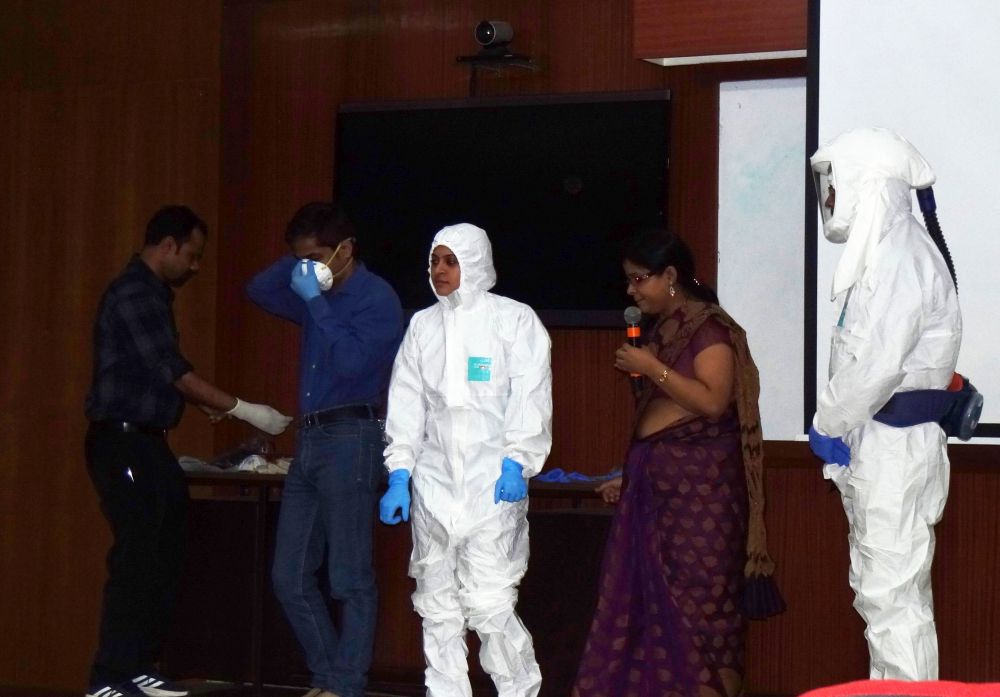
Pragya Yadav, Scientist, National Institute of Virology, demonstrating the biosafety training protocols at the workshop (Prashant Shukla)
A workshop on Biorisk Preparedness in Laboratory Setting, organized by the National Institute of Virology (NIV), Pune, was held at IISc on 11 April 2016. The goal of the workshop was to increase awareness about biosafety procedures and risk assessment in laboratories that handle infectious disease pathogens.
Dipankar Nandi, Department of Biochemistry, IISc, introduced the workshop to the participants. Lt. Gen. Dr. D Raghunath, who has served on the advisory committees of many research institutes, including NIV, spoke on why it was necessary to maintain an ethical code of conduct in laboratories which handle infectious agents.
Many of the emerging and re-emerging pathogens, such as those that cause SARS, H5N1 influenza and Nipah, are viruses. The diseases caused by these pathogens, collectively known as emerging infectious diseases, account for 26% of annual deaths worldwide caused by infectious pathogens, according to D T Mourya, Director, NIV, who led the workshop. The workshop, he said, could provide a framework for continuously raising awareness on the risk involved in handling dangerous pathogens.
Infectious agents are grouped primarily into four categories based on the risk they pose to the individual working with them, and to the community at large. This translates to four biosafety levels (BSL-1, BSL-2, BSL-3 and BSL-4) that are prescribed for handling pathogens from these categories. Biological safety cabinets, for instance, are accordingly designed to protect the researchers, the laboratory environment and the work materials from exposure to infectious aerosols that may be generated while working with samples containing dangerous pathogens. At NIV, the BSL-4 cabinet has specially engineered features to prevent microorganisms from being released into the environment.
To highlight the importance of the mandatory training received by all laboratory personnel handling infectious agents in BSL-3 and BSL-4 facilities, Pragya Yadav, NIV, conducted a hands-on training session at the BSL-3 facility in the Centre for Infectious Disease Research (CIDR), IISc. Amit Singh and S Vijaya, faculty members associated with CIDR, also took part in the workshop and helped students during a pre- and post-assessment session on safe laboratory practices.
*Manbeena Chawla is a Research Associate at CIDR.
Institute Colloquium: S Gopalakrishnan
Anupam Purwar*
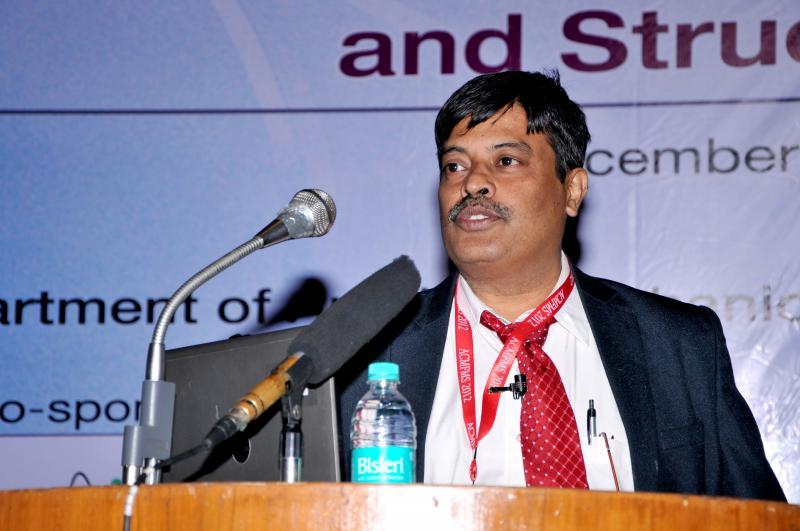
(Courtesy: S Gopalakrishnan)
In his now famous lecture There’s Plenty of Room at the Bottom made in 1959, the Nobel Laureate, Richard Feynman, wondered if we would one day be able to manipulate and control individual atoms and molecules. It was only later in 1974 that the term “nanotechnology” was coined by Norio Taniguchi.
The contributions of these visionaries formed the introduction to the Institute Colloquium given by S Gopalakrishnan on April 6, 2016, titled Wave Propagation in Nanomaterials and Structures. But it wasn’t until 1991 that researchers were able to make a significant breakthrough in the development of nanotechnology. This breakthrough occurred when a form of carbon known as carbon nanotube (CNT) was developed. Gopalakrishnan highlighted how the remarkable physical properties of CNTs help improve the performance of nanocomposites. Compared to steel, CNTs have superior tensile strength—100 times greater—despite being only a sixth as dense. Different forms of CNTs can be used for making various miniature sensors and actuators.
After highlighting the different approaches used in the theoretical modeling of CNTs—atomistic modeling, classical molecular dynamics, tight-binding molecular dynamics, density functional theory (DFT) and continuum mechanics modeling—Gopalakrishnan spoke about his study of the propagation of mechanical waves in quasicrystals.
The structure of a quasicrystal differs from that of crystals in that they are ordered but not periodic. A 3D quasicrystal tiling cannot have translational symmetry in more than two dimensions, unlike crystals which have periodicity in all three dimensions. While crystals can possess only two, three, four, and six-fold rotational symmetries, quasicrystals have other symmetry orders, such as five-fold.
The quasi-periodicity of the quasicrystals leads to two different displacement fields in the material: phonon and phason displacement modes. Gopalakrishnan spoke about his group’s work on computing the wavenumber and group-speed of the waves in these two modes in 1, 2 and 3D quasicrystals. His group has also developed characteristic equations to study the variation of wave number and group-speeds in various quasicrystals.
*Anupam Purwar is a Visiting Scientist at the Centre of Excellence in Hypersonics in the Department of Aerospace Engineering, IISc
WiSER 2016
Vrushal Pendharkar*
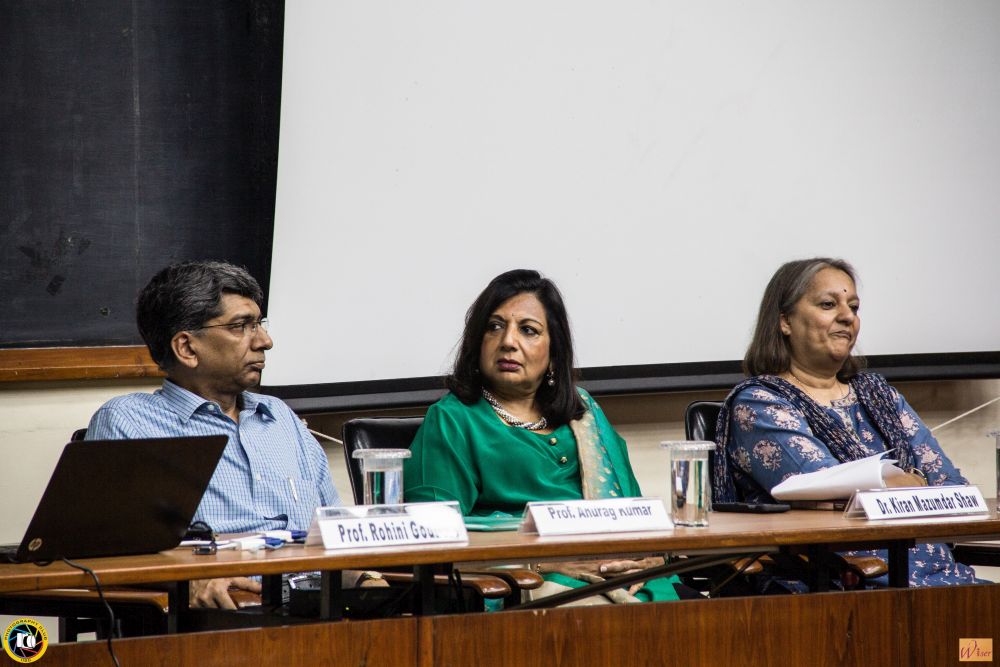
Anurag Kumar, Kiran Mazumdar Shaw and Sandhya Visweswariah at WiSER 2016 (IISc Photography Club)
“If I can get institutes to realise that something special needs to be done to encourage both young women students and faculty to prosper, then I would have achieved something,” said Rohini Godbole, professor at the Centre for High Energy Physics, IISc, setting the tone for the first Women in Science, Engineering and Research (WiSER) conference. Organized by the IISc Families and Friends Forum and the IISc Alumni Association on 2 April 2016 at IISc, the event brought together women, and men, from industry and academia to discuss the obstacles that women researchers face.
In his introductory remarks, Anurag Kumar, Director, IISc, highlighted a global problem: while there has been an increase in the percentage of girls in schools and colleges, the number of women who end up pursuing science drops dramatically (referred to as the “leaky pipeline” phenomenon). This was followed by a keynote address by Kiran Mazumdar-Shaw, Chairperson and Managing Director, Biocon Limited.
In the general panel discussion, moderated by NDTV journalist Maya Sharma, Sandhya Visweswariah (Department of Molecular Reproduction, Development and Genetics), felt that criteria for recognition in academia are tilted in favour of men. Mazumdar-Shaw shared experiences of the time when she was building her company, which made her determined to create more opportunities for women in leadership roles.
A second panel discussion addressed, among other things, the dilemma that women often face in trying to balance family life and work. One of the panelists, Narayan Sundaram from IIT Kanpur, admitted that men were aware of the problems faced by women in various spheres of life, but often lacked the vocabulary to express their support. One of the participants, a PhD student from Nigeria, said that in her country it is taboo for a girl to be studying science, but her parents nevertheless encouraged her to do so. Usha VijayRaghavan (Department of Microbiology and Cell Biology), felt that the path is easier for the current generation than it was a few decades ago.
The final session featured roundtable discussions in which participants had to propose, and later discuss with the audience, practical solutions to address various issues such as gender harassment, women’s health, and security.
This conference was intended to be a first step in the long road to creating an environment where gender sensitivity and justice are more than just buzzwords. One participant, Lipika Sahoo, CEO, Lifeintelect Consultancy Pvt. Ltd, said that empowering women is essential not only to build stronger societies but also robust economies. In conclusion, Vijayalakshmi Ravindranath echoed a widespread sentiment when she said that she hoped to see a day when there are no “women scientists” but just scientists who happened to be either women or men.
A version of this article appeared on IndiaBioscience.org
* Vrushal Pendharkar is a freelance writer
Designing for a Cleaner Nation
Navin S*
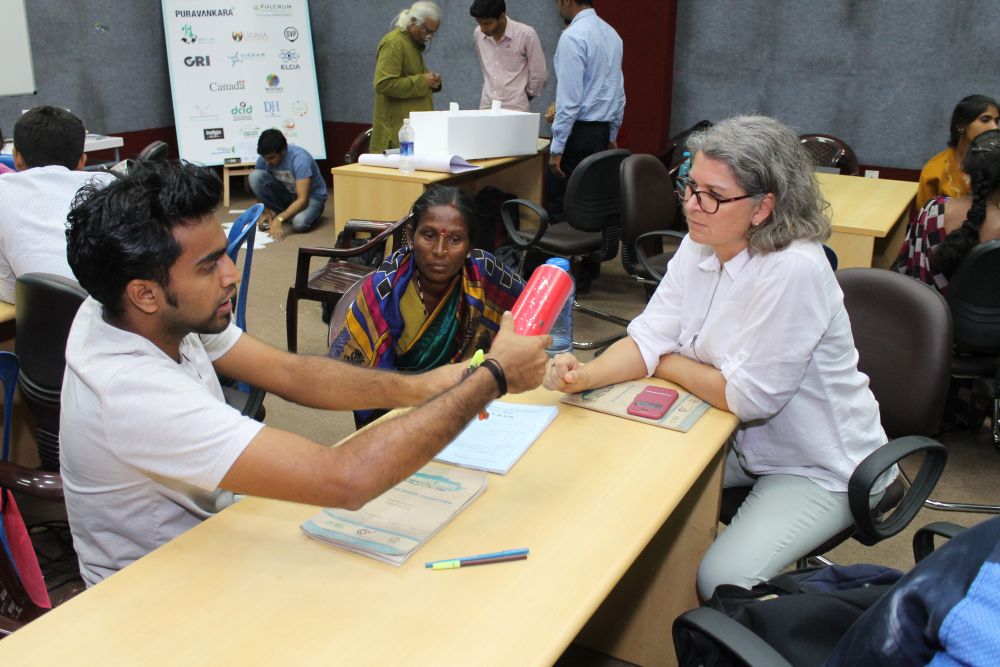
Participants during the Reimagine Waste Hackathon (Courtesy: Organizing Team, Reimagine Waste)
Reimagine Waste, a “design hackathon”, was organised at IISc by the Centre for Product Design and Manufacturing (CPDM) in association with the Centre for Infrastructure, Sustainable Transport and Urban Planning (CiSTUP) and Waste Impact, an NGO, spread across the two weekends of 26/27 March and 2/3 April, 2016. It was the first in a series of events that aims to tackle the growing garbage problem, particularly acute in Bangalore.
A hackathon is an event where participants are challenged to create readily implementable solutions. To this end, in the “Immersion” session on day one, about 200 participants, divided into multiple groups, visited various facilities―dry waste collection centres, incinerators, and landfills―across Bangalore and its outskirts. Based on this first-hand knowledge, they proposed, on day two, problem statements and divided into teams. Importantly, each team included at least one waste collector as the domain expert. On day three, the teams were provided with the raw materials, tools and machining facilities to “hack away” at the problem and come up with solutions in 24 hours. “In traditional workshops, participants only talk about what they’ve already done in their own silos––whereas, here we’re looking for creative solutions which impact the lives of waste collectors. We wanted the participants to have a much more interactive, engaging experience than just another knowledge sharing session,” said Gayitri Handanahal of Waste Impact, a member of the organizing team.
On the final day, the 12 finalists presented their solutions to a panel of judges comprising seasoned entrepreneurs, venture capitalists and domain experts. The teams were thoroughly grilled on various aspects such as the viability and marketability of their ideas. The first prize was won by a team from Infosys, Nitte Meenakshi Institute of Technology and Alliance University, which built a system involving a smartphone app, a wireless weighing scale, and a “gamification” platform that would enable waste collectors to record data about the waste collected at the source. Two special prizes were also presented for addressing specific challenges. One of them was awarded to a team from IISc for designing an improved ‘Waste Management Kit’––a safer and more comfortable waste collection gear and a battery-operated motorised pushcart.
The finalists have also been given an opportunity to refine their ideas and come up with marketable ventures within 45 days. “We would be happy even if one or two of these ideas become viable enterprises which make a real difference on the ground. In addition, an important side-benefit of the Hackathon is sensitization of participants to problems of waste management in our city and how they can be part of the solution rather than just the problem,” Manish Arora, a faculty member from CPDM and one of the brains behind this novel experiment, told CONNECT.
*Navin S is a Master’s student in the Department of Electrical Engineering
Think Nano
Debadrita Paria*
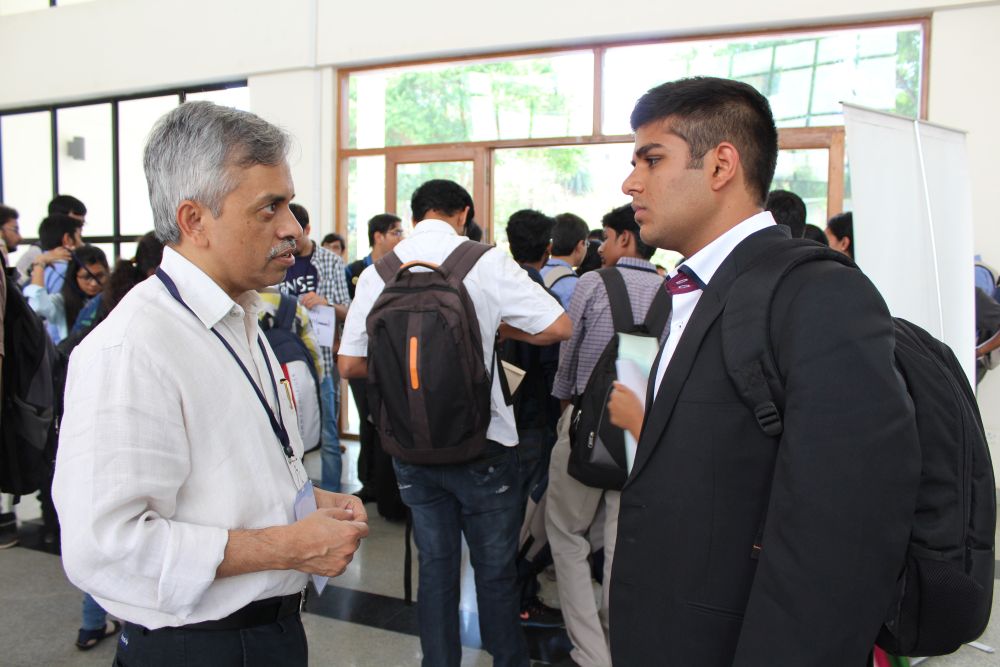
Rudra Pratap, Chairperson of CeNSE, interacting with a participant at Think Nano. (Debadrita Paria)
The Centre for Nano Science and Engineering (CeNSE) organized a National Student Symposium, Think Nano, on 31 March and 1 April 2016. The event, being held for the first time, was co-sponsored by the Airbus group.
Speaking during the inaugural session, Rudra Pratap, Chairperson of CeNSE, said that the idea behind conducting this event was to spread awareness among undergraduate students about the research and career opportunities available in nanoscience. On a different note, he encouraged the participants to “think nano”—to pay attention to the minute details of one’s research—to achieve something big.
G Rangarajan, Chairperson of the Division of Interdisciplinary Research, inaugurated the event and congratulated all the participants, who came from all over India, on being selected for the symposium. The chief guest, V Manjula, Principal Secretary, Department of IT, BT and S&T, Government of Karnataka, highlighted the importance of innovation before one can ‘make in India’. She said that the state government was keen to work with CeNSE in setting up technology business incubators to support start-ups and help convert their research into marketable products.
The symposium had sessions on commercial products that resulted from research at CeNSE—such as an air pollution monitoring system named Envirobat; a glucometer being commercialized by the start-up Prathshodh; pressure sensors for Light Combat Aircraft ; and an advanced chemical vapour deposition reactor for manufacturing graphene. There was also a panel discussion involving CeNSE industry partners, including Unilever, KAS Technologies, Centum Electronics, and Analog Devices.
The symposium also provided an opportunity for faculty members at CeNSE to host sessions highlighting their efforts in solving complex problems that require expertise in different fields. Speaking about the photonics research at CeNSE, Shankar Kumar Selvaraja said that photonics on a chip—using photons rather than electrons to encode, transmit and process information—might be the only way to enable high-bandwidth communication for a large number of users. Navakanta Bhat pointed out that electronics is perhaps the only industry where scaling down a product not only reduces its price, but also increases its performance. He also added that gallium nitride (GaN) has the potential to replace silicon in terms of performance and gave a glimpse of the progress researchers at CeNSE have been making towards this end. There were also sessions on micro and nano electromechanical systems (MEMS, NEMS), microfluidics and material research taking place at CeNSE.
V R Supradeepa, a faculty member at CeNSE and part of the organising committee of Think Nano, felt that it was an exciting experience for the entire CeNSE fraternity as well as for the visiting students.
The symposium saw 182 undergraduate students from colleges and universities all over the country present their research ideas in the form of posters. They got the opportunity to visit various laboratories and the nano fabrication facility, and to interact with members of a panel of graduate students at CeNSE who shared their research experiences. “The laboratory tour was very thorough and the way mentors explained about all the facilities patiently was truly appreciable”, Anjanashree, a B.Tech student from VIT University, told CONNECT.
* Debadrita is a PhD student at the Centre for Nano Science and Engineering
The 4th CBR Lecture: Understanding the Ageing Brain
Debaleena Basu *
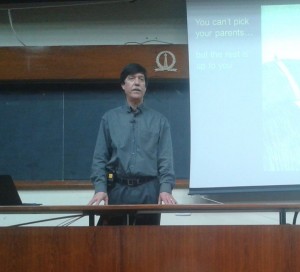
(Credit: Debaleena Basu/Murthy Dinavati)
As we get older, our cognitive abilities gradually deteriorate. This decline is much steeper if we are also afflicted by age-related disorders like Alzheimer’s disease, ultimately rendering the person unable to perform even day-to-day tasks. What is the underlying biology of these symptoms and the cognitive deficits brought about by such disorders? The fourth in a series of lectures being conducted by the Centre for Brain Research (CBR), IISc, shed light on this intriguing topic. Titled Biologic Architecture of Age-related Cognitive Decline, it was given by eminent neuroscientist and Director of the Rush Alzheimer’s Disease Center in USA, David A. Bennett, on 22 March, 2016.
To study the development of neurodegenerative diseases in functioning brains, researchers use animal models because they typically have access to only post-mortem human brains from donors. They then have to analyze such donated brains and correlate the findings with the clinical diagnosis which the patient had received while alive. To overcome this hurdle, Bennett explained that we should study physiological changes over many years preceding death in humans in order to track cognitive decline. He therefore initiated two cohort studies that monitored physiological and clinical data from diverse ageing populations for almost two decades, accumulating a wealth of information on age-related cognitive decline.
These pioneering studies show that individuals differ in how and when cognitive deficits set in with age. This led him to ask two questions which have become central to his research: Why it is that some people decline rapidly, some mildly, and some not at all? What is the basis of this variability? Over the years, he has investigated various factors that could affect or cause progressive cognitive decline with age, starting from neurodegenerative disorders, to different proteins that malfunction, to relevant psychological factors.
But identifying the causes of age-related cognitive decline is still a work in progress. The factors that have so far been identified explain only a little more than half of the total variability in how the cognitive decline manifests itself in different people.“We are beginning to build a model of various factors underlying cognitive decline. The more we know about the biological architecture of the process, the better are the chances of discovering drugs that ameliorate the effects of rapid cognitive deterioration that age and age-related disorders can bring about,” Bennett concluded.
*Debaleena Basu is a PhD student at the Centre for Neuroscience
SIAM-CPDM Design Workshop on Two-Wheeler Mobility Solution
Saleem Ahmed*
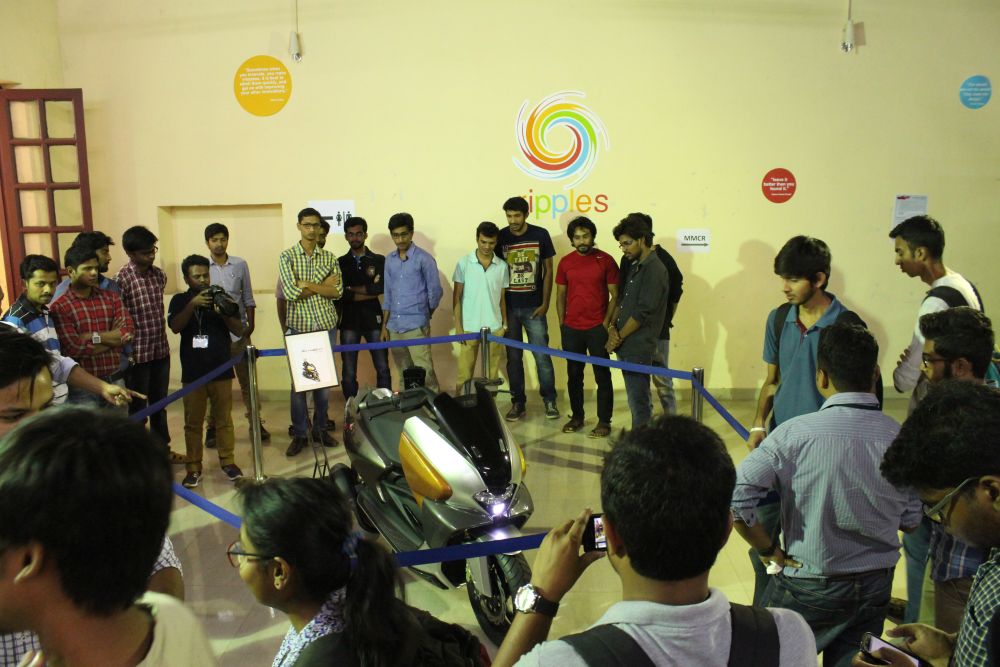
EntorQ 210, an award-winning concept scooter from TVS Motors, on display during the workshop (Courtesy: Vivek)
The Society of Indian Automobile Manufacturers (SIAM) organized their South Zone Design Workshop on Two-Wheeler Mobility at the Centre for Product Design and Manufacturing (CPDM) in IISc on 19–20 March, 2016. The workshop brought together some of the most renowned automobile designers in India to mentor the 55 student participants who were drawn from design schools across south India.
B Gurumoorthy, Chairperson, CPDM, welcomed the gathering and spoke about CPDM’s role in design education and research. Anil Saini, Chairman of Styling & Design Group, SIAM, in his introductory remarks about the workshop, said that the workshop aimed to help budding designers gain first-hand knowledge about automobile design from industry leaders and help them become better designers.
To this end, the first part of the workshop featured keynote speakers who spoke about the role of designers in creating future mobility solutions. This was followed by a hands-on session, in which students came up with their own two-wheeler designs to solve many of urban India’s transport problems. In this endeavour, they received guidance from professional designers of various automotive companies—such as Maruti, Tata, Ashok Leyland, TVS, Mahindra, Renault, General Motors—that are part of SIAM.
The workshop thus served to foster collaboration between industry and academia. Interactive sessions with the experts helped students understand career options that lie ahead of them as well as what expertise the industry seeks from designers.
The workshop also saw an inspiring exhibit—EntorQ 210, an award-winning concept scooter by TVS Motor Company, designed by a team comprising Arun Kumar Francis, alumnus of CPDM.
* Saleem Ahmed is a PhD scholar at CPDM, IISc, and was the Coordinator of the SIAM-CPDM Design Workshop
Spectrum 2016
Vikram Pal Singh*
The IISc Gymkhana houses 24 different sports and cultural clubs. In an event that brought all these clubs together, the Gymkhana Student Affairs Committee organized the fourth edition of Spectrum, the annual sports and cultural fest, on 17–20 March, 2016.
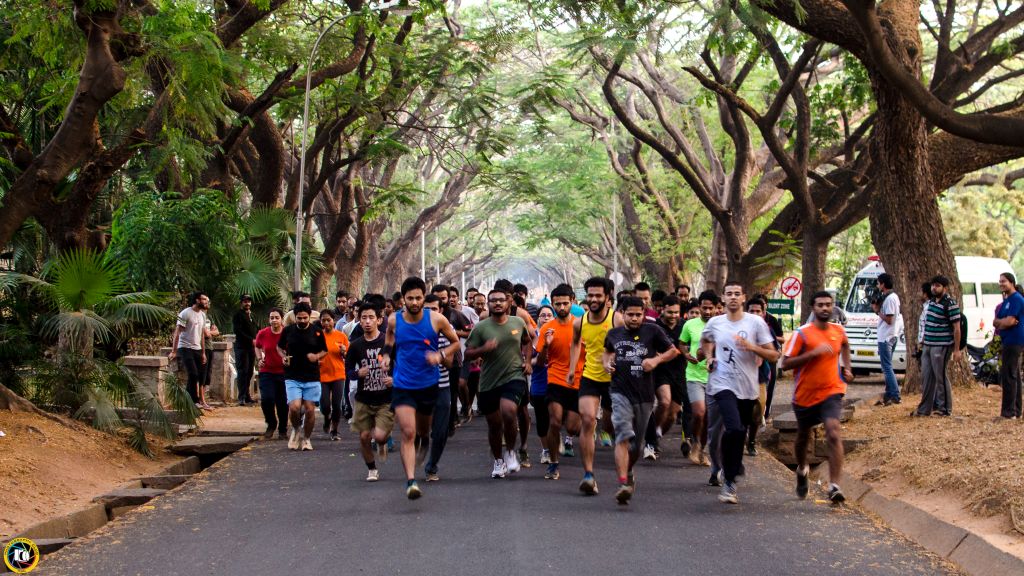
The Science and Technology run (Credit:Gymkhana Student Affairs Committee)
Unlike in previous years, participants from outside IISc were not invited in order to keep the event at a scale where every club could manage and organize their events with ease.
More than 80 different events were held as part of Spectrum 2016 with around 800 participants, comprising both students and staff.
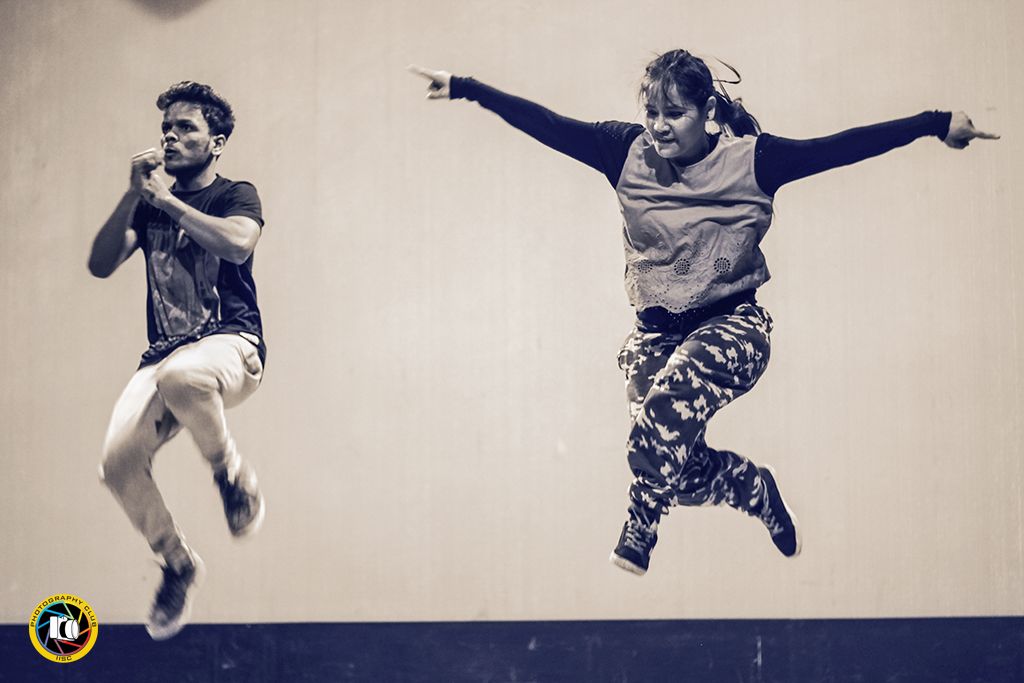
A performance by Nrityatarang, the IISc Dance Club. (Credit: Gymkhana Student Affairs Committee)
The sports events—such as the “Science and Technology run” (of 5 km), “Scienceman” (a triathlon with 500 m swimming, 15 km cycling and 5 km running), swimathon, a hockey exhibition match, frisbee matches, volleyball and football tournaments-were held in the mornings, while the cultural clubs such as the Nrityatarang, (IISc Dance Club), the IISc Music Club and the Rangmanch (IISc Drama Club) performed in the evenings.
*Vikram Pal Singh is the General Secretary of the IISc Gymkhana
Studying Cells as they Flow
Taru Verma and Syama Sreedharan*
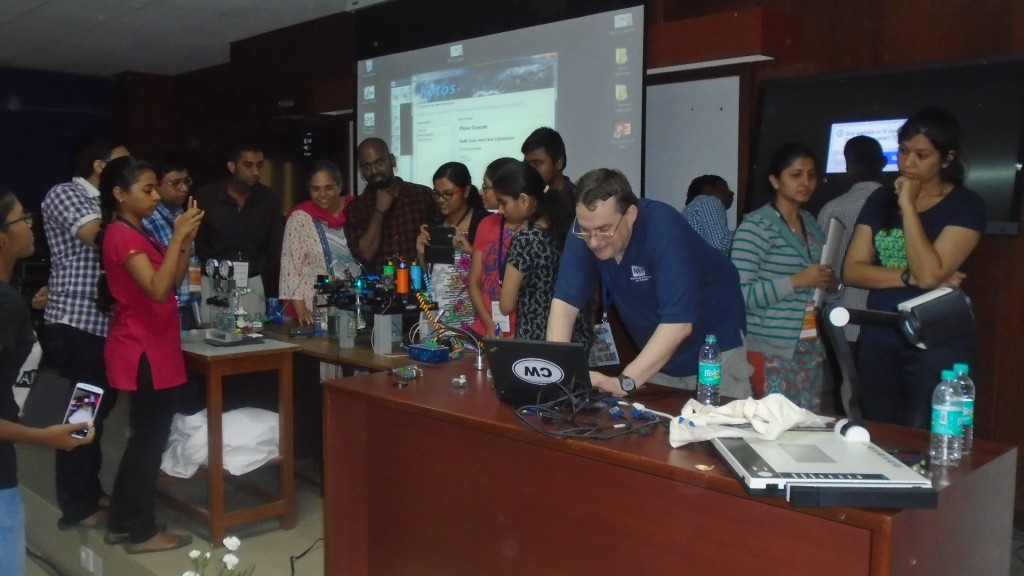
The “Build Your Own Flow Cytometer” session with William Telford. (Taru Verma/Syama Sreedharan)
Light, an essential ingredient of life, also has several applications in research in the life sciences. One of these is a technology called flow cytometry wherein a stream of single cells or particles is passed through an illumination point, and hit with coherent beams of laser light of specific wavelengths, leading to scattering of photons. The information that the scattered photons carry can be used to measure and analyze the physical and chemical properties of the cells or particles. This technology is becoming immensely popular in the scientific community due to its many applications, particularly in medical research—such as the identification of immune cell subsets like CD4+ T lymphocytes during AIDS progression and the typing of different types of cancers.
Given the importance of flow cytometry in biology, a symposium and hands-on workshop was organised with the aim of educating graduate students and faculty on the basics and applications of this technique. The 17th Indo–US Cytometry Workshop on Applications of Laser Flow Cytometry in Biomedical Research was jointly organized by IISc, National Centre for Biological Sciences and the International Society for Advancement of Flow Cytometry, USA, on 14–18 March, 2016.
“In flow cytometry, it is often true that the devil is in the details and these workshops help people to understand these details”, said Joseph Trotter, Principal Scientist at BD Biosciences, USA. In keeping with this spirit, students had the opportunity to handle the equipment and learn first-hand from experts. The star attraction was the “Build Your Own Flow Cytometer” hands-on module conducted by William Telford of the National Institutes of Health, USA. He explained how every single component in the instrument can be easily assembled on a bench to build a functional flow cytometer. The entire process took about two hours and was a very useful teaching module.
The workshop saw many other renowned cytometrists like Awtar Krishan (University of Miami, USA), Zofia Maciorowski (Curie Institute, France), Sumeet Gujral (Tata Memorial Centre, Mumbai), Vineeta Bal (National Institute of Immunology, New Delhi), among others, deliver informative talks and conduct wet lab modules. Some of the modules were taught by scientists working in industry, which led to a healthy interaction between researchers in academia and those in industry. Several speakers cautioned students on the intricacies in interpreting flow results.
Participants for this workshop were selected from institutions all over the country. One of them was Sabyasachi Pradhan, a PhD student from Jawaharlal Nehru University. “Coming from a non-flow cytometry background, I gained a lot of experience and knowledge in this field. I would recommend this workshop”, she told CONNECT. The event concluded with the participants enjoying a Yakshagana performance.
* Taru Verma and Syama Sreedharan are PhD students in the Department of Biochemistry, IISc
Institute Colloquium: Rudra Pratap
Nithyanand Rao*
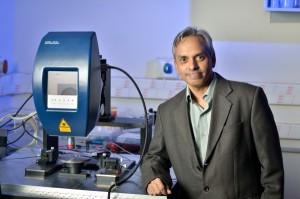
(Manoj Sudhakaran)
“Scientific research alone does not take you where you want to be. How do you overcome the temptation to stop after publishing your paper?” asked Rudra Pratap, Professor and Chairperson, Centre for Nano Science and Engineering (CeNSE), while giving an Institute Colloquium at IISc on 16 March, 2016.
In the talk, titled Turning Science into Technology: Narratives of Some Exhilarating Experiences, Pratap addressed the question of how to turn scientific research driven by curiosity into technology and, eventually, innovative products. He did this by drawing on some of the recent research projects from his lab as well as those of his colleagues at CeNSE, which he played a key role in founding in 2010.
His first example of a technology emerging from basic research involves a phenomenon known as electromigration: In a conductor, electrons moving under the influence of an electric field transfer their momentum to the atoms, resulting in transport of material. This process is pronounced in metals at the nano-scale, making nano-circuits made of metals more prone to damage. But metals are still preferred over semiconductors in nano-circuits because semiconductors lose their desirable properties at this scale.
In investigating this phenomenon, Pratap and his team observed that when an electric current is passed through a thin film of chromium coated on an insulator, chromium melts and flows away from the negatively-biased electrode. That chromium could melt at the ambient room temperature was a surprise. The team pursued this further, and found that moving the electrode presented them with a method of etching patterns which could then be imprinted onto a suitable material for making nano-sized circuits. This technology, called electrolithography, is faster and cheaper than existing methods of patterning. What’s more, the method does not use toxic chemicals and can be used to etch circuits at different resolutions.
Pratap’s second example came from a very different line of enquiry. He was fascinated by the work of researchers at the Centre for Ecological Sciences, IISc, on crickets. Males of these small insects sing by rubbing one of their forewings against the other. The intensity of the sounds produced is amplified by a thickened part of the wing called the harp, making the sounds produced louder than those of speakers of comparable size. Pratap’s team modelled the stridulation of the wings, and the harp using an approach called finite-element method. The simulation was able to closely reproduce the song of a cricket, both its frequency and intensity. But once again, Pratap’s team went further by implementing this on a microelectromechanical device, thus creating micro-speakers based on technology inspired by nature.
His third instance of turning science into technology was a more direct application of basic research. Pratap and collaborators have developed a method of detecting diseased biological cells by measuring their vibrations at nanometre amplitudes when subjected to stress.
The final part of his talk, which Pratap dubbed ‘Watching From the Dugout’, was devoted to providing two examples of how his colleagues at CeNSE are also translating their research into marketable technologies. The first example he gave was that of a diabetes detection sensor that has been developed by Navakanta Bhat (also a professor at CeNSE) and his student Vinay Kumar. Bhat and Kumar have now started a company called PathShodh which now makes a handheld device that uses this sensor to detect diabetes accurately and quickly.
Pratap concluded his talk by presenting a glimpse of a project being led by Srinivasan Raghavan: developing the technology for a commercial foundry which can grow gallium nitride on silicon more cheaply, a process which is important for the semiconductor industry.
*Nithyanand Rao is a Consultant Editor at the Archives and Publications Cell
Symposium on Infectious Disease and Immunology Research
Manbeena Chawla*
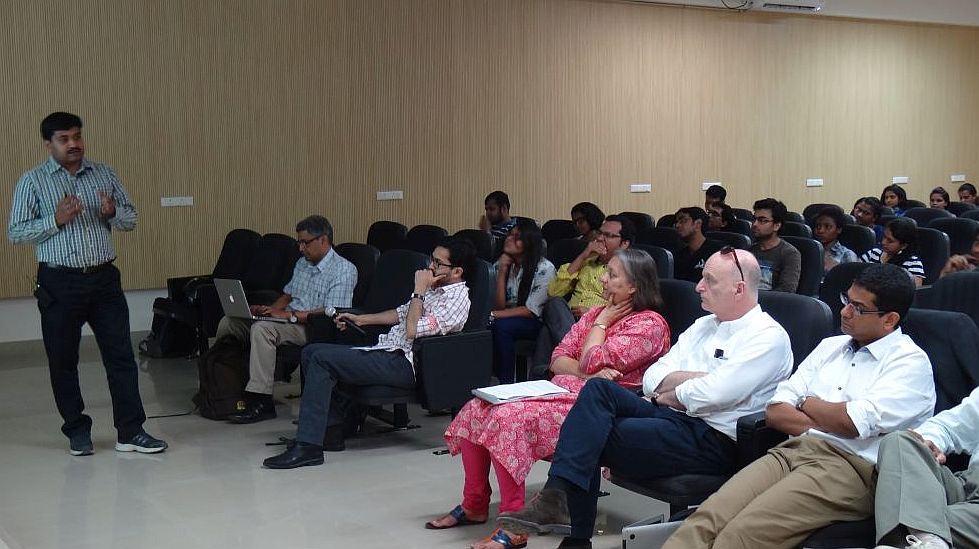
Amit Singh, Assistant Professor, Department of Microbiology and Cell Biology/Centre for Infectious Disease Research, IISc, speaking at the symposium. (Manbeena Chawla/Richa Mishra)
A symposium, sponsored by the Centre for Infectious Disease Research (CIDR), IISc, and the Infosys Foundation, titled Initiative for Infectious Disease and Immunology Research at IISc and Imperial College London (I for I5), was held on 9–10 March, 2016.
One of the major themes addressed at the symposium was the growing threat of antibiotic-resistance in disease-causing bacteria. Underlining the seriousness of this issue, Gad Frankel, from the Department of Life Sciences at Imperial College, said, “There has been a huge increase in the spread of drug-resistant bacteria which is a matter of concern. New antibiotics have been discovered over this time, but very few of them have been approved so far.” Besides antibiotic resistance, the issue of the emergence of new infectious diseases also received special attention at the symposium.
Frankel’s colleague Sivaramesh Wigneshweraraj, from the Centre for Molecular Bacteriology and Infection at Imperial College, emphasized the importance of understanding the mechanism of bacterial virulence as we seek to develop new antimicrobial treatments and vaccines.
Other topics of discussion during the symposium included infection genomics, host immune response, cellular and structural microbiology. Faculty members from various departments at IISc, besides CIDR—Biochemistry; Chemical Engineering; Microbiology and Cell Biology (MCB); Molecular Reproduction, Development and Genetics (MRDG); and Materials Engineering—shared their research findings on many infectious diseases, including on one of the world’s most lethal bacterial infections, tuberculosis.
Amit Singh of CIDR spoke about the redox sensing capability of the Mycobacterium tuberculosis which helps it to persist within the host organism. Deepak Saini of MRDG and N Ganesh of the Department of Biochemistry also highlighted the special capabilities of bacteria which help it overcome the host’s defenses.
On the other hand, Annapurna Vyakarnam from CIDR and Nagasuma Chandra from the Department of Biochemistry discussed their research on the infected host.
Students, such as Richa Mishra who is doing her PhD at the Department of MCB, found this symposium extremely useful. Mishra was particularly delighted by the opportunity to interact with leading researchers as well as the exposure she got to cutting-edge research in her field. “One gets to understand so much about the current scenario of bacterial infections spreading all over the world,” she told CONNECT.
*Manbeena Chawla is a Research Associate at CIDR
Workshop on Indo–French Collaboration in Marine Biology and Biotechnology
Aditi Jayaram*
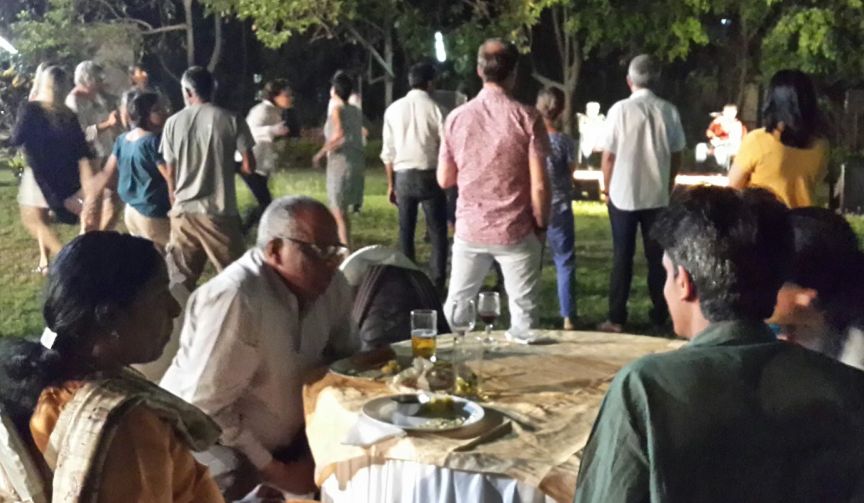
Participants from the workshop relaxing over dinner (Courtesy: Dr. N V Vinithkumar)
IISc and the Dakshin Foundation, Bangalore, jointly organized an Indo–French workshop titled Exploring the scope of collaborations in Marine Biology and Biotechnology between France and India on 7–9 March, 2016 at the Biological Sciences Auditorium, IISc.
“The workshop provided an appropriate platform to understand diverse aspects of the vast coastline of India and to highlight the expertise of the French scientists in marine biology,” said Srini Kaveri, the Director of the Indian office of Centre National de la Recherche Scientifique (CNRS), France. The CNRS was one of the agencies with whom the Department of Biotechnology (DBT), Government of India, partnered for the event. The other partners supporting the event were the Sorbonne University—including Université Pierre et Marie Curie (UPMC) which jointly administers the three major French marine institutes at Roscoff, Banyuls-sur-Mer and Villefranche-sur-Mer—and the Science & Technology Section at the French Embassy in India. This is part of a larger collaborative effort which aims to set up a state-of-the-art institute for marine biology and biotechnology in India.
During the workshop, Chris Bowler (Institut de Biologie de l’Ecole Normale Supérieure, France) spoke about the global patterns of diatom diversity revealed by the Tara Oceans expedition, a research expedition that travelled around the world in 2009–2013 to study CO2 sequestered by marine microorganisms. Nadia Ameziane (Muséum natural d’Histoire naturelle, Paris, France) discussed the challenges faced by biologists working in “extreme” marine environments. Other speakers highlighted the use of model organisms such as metazoans and brown algae to study cell and developmental biology in marine ecosystems.
Eric Thiebaut (UPMC, France) talked about the challenges in the long term observation of the community of planktonic organisms and of the life found in the benthic zone, at the depths of the ocean. In this context, he highlighted the importance of historical data and sample collection. Maria Thanker from the Centre for Ecological Sciences (CES), IISc, discussed how predator-induced trophic cascades affect species composition as well as behaviour and physiology of prey. Kartik Shanker (Director, Ashoka Trust for Research in Ecology and the Environment on deputation from CES) showed that anti-predation benefits seem to drive grouping in mixed species foraging associations in birds and fish. Shannon Olsson (National Centre for Biological Sciences) presented her work on chemical ecology and Daniel Vaulot (CNRS) spoke about the Roscoff Culture Collection, which maintains 3635 strains of marine microalgae, bacteria and viruses. These strains have been isolated from various oceanic regions and have also been obtained from other collections.
The conference concluded with a panel discussion on research collaborations between France and India. Such joint work, said Shanker, would help the rapid advancement of the field by exploiting the strengths of, and synergies between, the research groups in the two countries. “Much of India’s marine biodiversity is unexplored. We need to understand the ecology and biology of these systems to enhance our basic knowledge, to conserve them and to use them in a sustainable fashion,” he added. To this end, the DBT proposes to establish, with assistance from the French, a National Institute of Marine Biology and Biotechnology that will integrate modern biology—imaging, genomics, proteomics, systems biology and computational biology—with classical marine biology.
*Aditi Jayaram is a project student at CES
Professor A. Srikrishna Memorial Lecture 2016
Biswajit Sarkar*
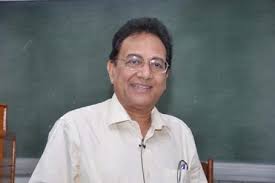
Ganesh Pandey (Courtesy: NCL)
Ganesh Pandey, the Director of the Centre of Biomedical Research, Sanjay Gandhi Post-Graduate Institute of Medical Sciences, Lucknow, delivered the Prof. A Srikrishna Memorial Lecture on 7 March 2016 at the Faculty Hall, IISc.
In his lecture, Pandey spoke about how, during the course of his career, his research focus shifted from the synthesis of smaller molecules to that of larger ones that are found in nature.
He said that such research that aims to synthesize complex natural molecules acts as a driving force for innovations in organic chemistry.
He also discussed about some of the methods that he has recently developed for the synthesis of two molecules with medical importance, namely, Aspidophylline A and Dendrobine, from a common precursor. This common precursor is an optically active de-symmetrized synthon. This research opens up the possibility of synthesizing different natural products having a similar structure from a known and well established synthon.
Pandey also spoke warmly of his memories of Prof. A Srikrishna, who passed away in January 2013, and in whose memory this lecture series is organized by the Department of Organic Chemistry in IISc.
*Biswajit Sarkar is a student in the Integrated Ph.D. programme in the Department of Organic Chemistry
IISc Open Day 2016
Sudhi Oberoi*
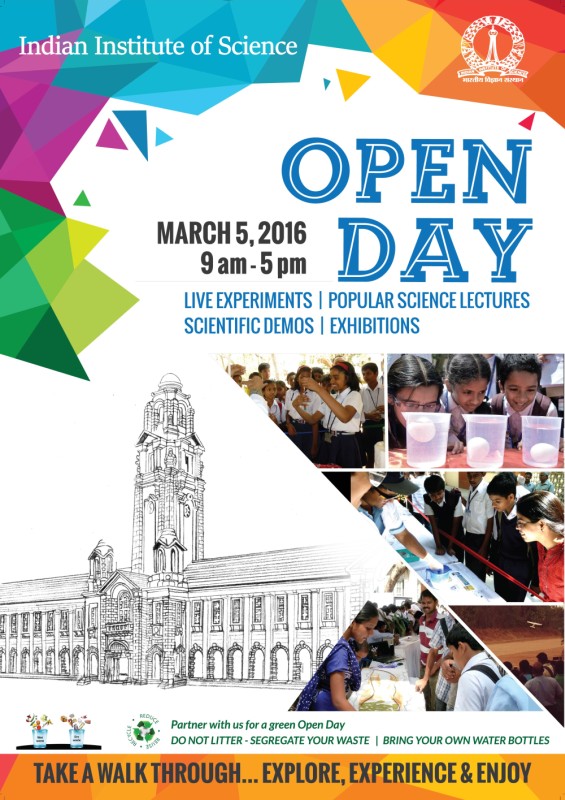 Open day is an annual outreach event organized by IISc to coincide with National Science Day (celebrated on 28 February) and Founder’s Day (3 March). It was on 28 February in 1928 that CV Raman working with his colleagues at the Indian Association for the Cultivation of Science, Kolkata, discovered what came to be known as the Raman Effect, a discovery that fetched him the Nobel Prize and revolutionized the field of spectroscopy. Raman eventually became the first Indian Director of IISc in 1933. He also founded the Department of Physics in the Institute. 3 March, on the other hand, marks the birth anniversary of Jamsetji Nussarwanji Tata, the founder and benefactor of IISc.
Open day is an annual outreach event organized by IISc to coincide with National Science Day (celebrated on 28 February) and Founder’s Day (3 March). It was on 28 February in 1928 that CV Raman working with his colleagues at the Indian Association for the Cultivation of Science, Kolkata, discovered what came to be known as the Raman Effect, a discovery that fetched him the Nobel Prize and revolutionized the field of spectroscopy. Raman eventually became the first Indian Director of IISc in 1933. He also founded the Department of Physics in the Institute. 3 March, on the other hand, marks the birth anniversary of Jamsetji Nussarwanji Tata, the founder and benefactor of IISc.
This year Open Day was organized on 5 March. Thousands of students, parents and science enthusiasts visited the sprawling campus of IISc to witness science first hand. Labs across all departments also setup interesting science and technology demonstrations. Some of the major attractions included the electric scooter at the Centre for Product Design and Management, motion-sensing devices at the Centre for Biosystems Science and Engineering, tour of the “clean room” at the Centre for Nano Science and Engineering and an aero show, which saw aircrafts developed in-house, conducted by the Department of Aerospace Engineering.
Some snapshots of the event, courtesy, IISc Photography Club, are displayed below.
[metaslider id=3204]
*Sudhi Oberoi is a Project Trainee at the Archives and Publications Cell (APC)
National Science Day Celebration by Notebook Drive
Debadrita Paria *
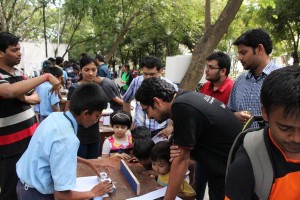
(Courtesy: Notebook Drive)
Notebook Drive (NBD), a student-run voluntary organization at IISc, helped students from Bagalkunte Government High School organize a science fair on National Science Day, 28 February, 2016. It was on this day in 1928 that C.V. Raman—who later served as the Director of IISc from 1933 to 1937—discovered what came to be known as the Raman effect.
NBD has been working to improve the quality of education in Bagalkunte Government High School (BGHS) and other underprivileged government schools in and around Bangalore for the past 14 years. They do this in various ways, including distributing notebooks, giving scholarship to students in need of financial support, holding English and computer classes, training teachers, and organizing free eye check-up camps. NBD also has a ‘Mentorship Initiative’. The science fair organized on National Science Day was part of this initiative. NBD volunteers mentored 25 students from BGHS for several months to do science and maths experiments.
The science fair was hosted near the C and D hostel messes, and saw a large number of attendees. Interesting experiments explaining the basic laws of physics, chemistry, biology and mathematics were demonstrated by the kids. Highlights of the program included making a battery using lemon, explaining the conversion of solar energy to electricity, solving a problem of bridge construction using the Fibonacci series, and demonstrating phenomena like magnetic levitation and the capillary effect in cells. One of the teams made a robot named Mars Rover. They built this robot after they were inspired by a talk on NASA’s Mars Rover that Gajanana Birur, a scientist at Jet Propulsion Laboratory, NASA—also an IISc alumnus and the co-chair of the IISc Alumni Association North America—had given in their school. “It is the duty of us, ‘the chosen few at the Institute’, to motivate the younger generation of Indians to take up science so that they may contribute to lift our society to a higher standard of living,” Birur told CONNECT.
“Whenever we make some model or find something, others will just appreciate us, but only people in the Institute ask us ‘Why is it happening?’, ‘What is the reason behind this?’, and also encourage us to think about these things,” said Archin, one of the participants. As a participation prize, the school students received science books in Kannada.
It was a fun-filled event not just for the school children who participated, but also for the NBD volunteers and the entire student community who attended the exhibition. One of the volunteers was Shravan, a student at the Supercomputer Education and Research Centre (SERC), IISc. “Spend some time with the kids and your day is made. The burst of enthusiasm, the sense of wonder and curiosity, smile on their cute little faces for no reason, their innocent acts…it was an opportunity to relish my childhood days,” he said, speaking to CONNECT.
“It was very inspiring to see the school children demonstrate and explain their projects with so much confidence and commitment. That was a clear reflection of the impact the science mentorship programme has had on these kids,” said Sridhar, an IISc alumnus currently working with Akshara Foundation, an NGO, who attended the science fair. To help NBD better plan the Mentorship Initiative in the future, each attendee was given an evaluation form to grade the experiments.
*Debadrita Paria is a PhD student at the Centre for Nano Science and Engineering
Conference on Municipal Solid Waste Management
Ellen Brock*
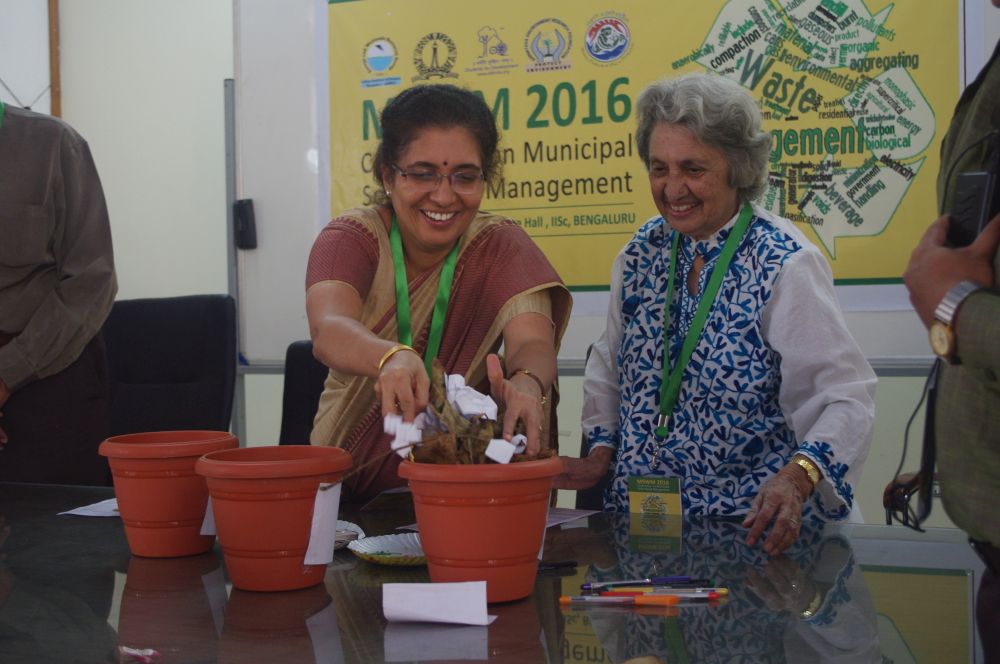
Almitra Patel and Tejaswini Ananth Kumar at MSWM 2016 (Courtesy: Vinay S)
A conference on Municipal Solid Waste Management (MSWM) was held at IISc on 23 and 24 February, 2016. The event was jointly organised by the Energy and Wetlands Research Group (EWRG) at the Centre for Ecological Sciences, IISc; Students for Development; and the Karnataka Environment Research Foundation.
During the inaugural session, Almitra Patel, who raised a public interest litigation in the Supreme Court in 1996 against open dumping of municipal solid waste, spoke on how electronic-waste is still a major challenge today. She gave the example of the poor regulations governing the disposal of tube lights, which contain mercury. TV Ramachandra, Convenor of MSWM 2016 and Co-ordinator, EWRG, explained his proposal of an incentive-based system to encourage segregation at the source, a suggestion that, he said, has been accepted in principle by the Mayor of Bangalore city.
Other speakers spoke about how individuals can make a difference by more responsible disposal of waste in their own homes, offices and organizations. Tejaswini Ananth Kumar of Adamya Chetana, an organization that serves mid-day meals to over two lakh school children each day, pointed out that they do not use bins to dispose food waste in their kitchens. Instead, they deposit it in a small biogas plant; the biogas it generates helps them save fuel too. Similarly, Ramakant, a well-known solid waste management activist based in Bangalore, and a member of the Solid Waste Management Round Table (SWMRT)—a forum of various Bangalore-based organizations and individuals working to promote sustainable waste management practices—advised the attendees on how to do composting in-house so as to reduce the load on the Bruhat Bengaluru Mahanagara Palike (BBMP). Nupur Tandon of Pro Waste spoke about how institutions and government organisations can better manage the waste they generate. Pavana, ninth standard student from K.K. English High School, Varthur, explained how this is done in her school and, moreover, how she and her fellow students also help the neighbouring areas. Malini Parmar, also a member of SWMRT, explained how the 2-bin-1-bag system—a green bin for food waste, a red bin for sanitary waste and a bag for dry waste—mandated by the Karnataka High Court, was successful deployed in select wards of Bangalore.
The conference also emphasized the importance of addressing systemic changes. Rajasekara Murthy, a Canadian environmental scientist, spoke about how cities that are rapidly expanding, such as Bangalore, need scientific solutions for resource management and for waste disposal. Sarfaraz Khan, Solid Waste Management (SWM) Cell, Joint Commissioner of BBMP Yelahanka, listed some of the innovative solutions that his team has come up with to tackle problems faced by citizens. These include: a proposal to place GPS receivers in autorickshaws that pick up waste, volunteers to monitor the immersion of Ganesha idols in water bodies, BBMP officials of the SWM Cell making themselves more visible and accessible, a ban on plastic bags, and a proposal for residents’ cards to hold waste records. They also provide meals and organize health camps for waste-pickers. Nalini Shekar, Founder-Director of Hasiru Dala, also works to improve the livelihoods of waste-pickers. She explained how waste-pickers were given ID cards to facilitate their integration into the waste collection process at the BBMP Dry Waste Collection Centres.
The conference saw many presentations, including posters by students, research scholars and representatives of various companies and resident welfare associations. They covered topics ranging from data gathering initiatives related to waste management, disposal of construction and debris waste, challenges in dealing with various kinds of waste—such as that from the poultry industry—and the use of messaging apps like WhatsApp for better communication.
*Ellen Brock is a consultant in data analytics and an alumnus of the Environmental Management Course, Centre for Continuing Education, IISc.
Molecules in Living Cells
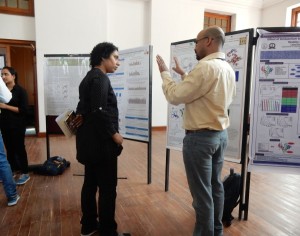
(Disha Mohan)
The Molecular Biophysics Unit (MBU), IISc, hosted the annual meeting of the Indian Biophysical Society from 8-10 February, 2016. The theme of the conference was Molecules in Living Cells: Mechanistic Basis of Function.
Inaugurating the event, Raghavan Varadarajan, Chairperson of MBU, said that the idea of holding such an event “is to get people in the biophysical community from around the country to come together and share ideas.”
There were talks on various topics ranging from structural studies of the basic molecules of life—DNA, RNA and proteins—to the application of MRI in cancer. The speakers included researchers from around the country, such as Ruchi Anand of IIT Bombay, Rishikesh Narayanan of MBU, Suman Kundu of Delhi University, Rahul Banerjee of the Saha Institute of Nuclear Physics, Kolkata, and NR Jagannathan of the All India Institute of Medical Sciences, New Delhi. There were also talks by leading researchers from outside India including Michael Sheetz, founding Director of the Mechanobiology Institute at the National University of Singapore (NUS), Singapore, and Linda J Kenney who holds a joint appointment at NUS and the University of Illinois-Chicago, USA.
The GN Ramachandran lecture was delivered by C Ramakrishnan, a retired professor from MBU, who had worked with Ramachandran in developing his eponymous plot. “It was a truly inspirational and enthralling experience to listen to Prof. Ramakrishnan and the history behind the Ramachandran plot from one of its creators,” said Mahavir Singh, an assistant professor at MBU.
Research scholars from institutions across India presented more than 80 posters on topics ranging from neurophysiology to crystallography to clinical medicine.
Disha Mohan
Pravega 2016
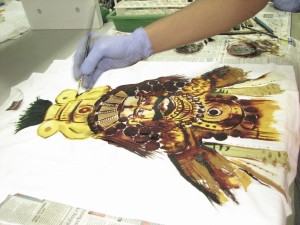
A T-shirt being painted by a participant of the Molecular Murals competition (POOJA NATHAN)
The third edition of Pravega, the annual technical and cultural festival of IISc, organized by the Institute’s undergraduate students, was held in the campus from 28-31 January, 2016.
The opening night featured music and dance performances by undergraduate students, the highlight being a contemporary reworking of Tagore’s classic dance opera, Tasher Desh (Land of the Cards). The featured events included the Microsoft Data Science Student Challenge, a 24-hour hackathon where participants were asked to come up with interesting and potentially useful trends by analyzing public health-related data. There were also other technical events, such as Whodunnit, in which participants had to solve a “murder” using biology-based clues; Molecular Murals, a T-shirt painting competition in which one had to synthesize colours from chemicals provided; and Auction, where the objective was to maximize one’s net-worth given the same starting capital. The fest also saw several quizzes, puzzle-based events and workshops.
Among the cultural events were the finals of Battle of Bands, a music competition featuring rock bands from around the country, held on the first night, followed by a concert by Lagori, a folk rock fusion band. The second night had a performance by Thermal Projekt, a well-known DJ, and the final night had a concert by Agnee, an Indo-rock fusion band.
Sayantan Khan (with inputs from Pranandita Biswas)
Book launches
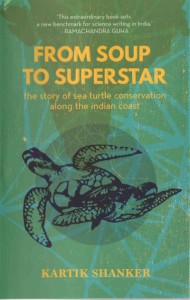
(Courtesy: Megha Prakash)
As a young student at the Madras Christian College in Chennai, Kartik Shanker spent much of his time walking along the Chennai coast – observing turtles that came offshore to nest and lay eggs. Soon his fascination for these animals grew and he started studying them.
Shankar, now a professor of marine biology at the Centre for Ecological Sciences in IISc, has written a book about turtles called From Soup to Superstar: The Story of the Sea Turtle Conservation along the Indian Coast. The book, published by Harper Litmus, was launched at an event in IISc by the famous historian-writer, Ramachandra Guha on 8 January, 2016.
Besides chronicling the early history of turtle biology and conservation initiatives, Shanker’s book provides a rich account of the work done by conservationists and enthusiasts whose contributions have added to better understanding of turtles.
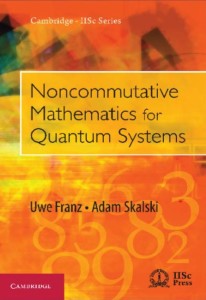
(Courtesy: CCS)
The Centre for Contemporary Sciences (CCS) at IISc organized two book events in January. The first event, co-organized by IISc Press on 11 January, 2016, saw the launch of Non-commutative Mathematics for Quantum Systems by Uwe Franz and Adam Skalski, published by IISc Press and Cambridge University Press. The monograph resulted from series of lectures delivered by authors at the Indian Statistical Institute, Bangalore in 2013. Uwe Franc is a Professor at the University of Franche-Compté, France, and Adam Skalski is an associate professor at the Institute of Mathematics, Polish Academy of Sciences, Poland. The book is divided into two parts, the first focusing on quantum probability and quantum stochastic processes, and the second on quantum dynamical systems. The book release was followed by a keynote lecture by Amrita Shah whose book Ahmedabad : A City in the World was published a few months ago.
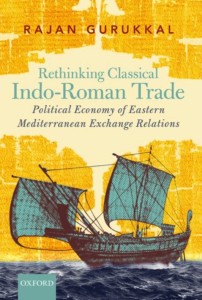
(Courtesy: CCS)
On 13 January, 2016, in the second event, Rajan Gurukkal’s Rethinking Classical Indo-Roman Trade: Political Economy of Eastern Mediterranean Exchange Relations, published by Oxford University Press, was released.
In this book, Gurukkal, an eminent scholar and a visiting professor at CCS, seeks to revise our understanding of the nature of the classical eastern Mediterranean exchange relations with the Indian sub-continent.
Ankit Ruhi and Megha Prakash
Urbanization and the Environment
The 8th Biennial Conference of the Indian Society for Ecological Economics (INSEE) was held at IISc during 4-6 January, 2016. The conference was hosted by the Department of Management Studies, IISc, in association with the Ashoka Trust for Research in Ecology and the Environment (ATREE) and the National Institute of Advanced Studies (NIAS).
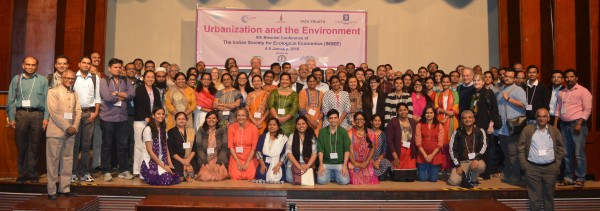
The conference, whose theme was Urbanization and the Environment, was attended by close to 200 participants from 12 countries, which included people from the academicians, policy makers and activists. It saw 6 interactive roundtable discussions and several parallel sessions that covered themes such as industrialization and climate change, culture, consumption and sustainability of cities, urban commons, urban environmental governance, rural–urban environmental and resource linkages, water and air pollution, and waste management in cities.
The conference was inaugurated by Sunita Narain, Director General of the Centre for Science and Environment (CSE). In her talk, she asked, “Is the term ‘sustainable cities’ not an oxymoron, given that cities use huge amounts of resources, emit, excrete and discharge huge amounts of waste?” Keynote addresses during the conference featured some of the leading names in the fields of ecological economics and development studies, such as Joan Martinez Alier, who spoke on the emerging trends in responses to environmental impacts of economic growth, and Barbara Harriss-White who dealt with the vital role played by the informal economy in urban waste management. Sarath Guttikunda, Founder Director of www.urbanemissions.info, emphasized the role of data in dealing with air pollution.
The organizers expect that the conference will go beyond stocktaking of current trends in the scholarship in the field, and set in motion a dialogue on sustainability and management of urban environments.
Soumyajit Bhar (With Inputs From Bejoy K Thomas)
Science and Beyond
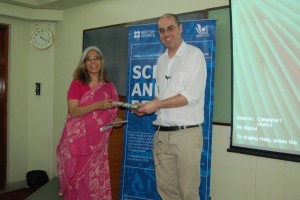
Jon Agar receiving a memento from Amrita Shah of CCS (Geetha SN)
On 6 January 2016, Jon Agar, Professor of Science and Technology Studies at the University College London, UK, gave a lecture at the Centre for Contemporary Studies titled What are the big themes of the history of twentieth century science?. He said that the biggest themes of 20th century science included the role of nation states in how science is done, increase in the scale of science, swing in the emphasis from physical to life sciences, and applied science driving discoveries. The lecture was part of the Science and Beyond series of public talks organized by the British Council and IISER Pune.
In another event, organized as part of the same series on 13 January, 2016, Carol Trager-Cowan from the University of Strathclyde, UK, gave a lecture at the Department of Molecular Reproduction, Development and Genetics titled Engaging the Public with Science and Technology—from Statues to Rainbows. Trager-Cowan spoke about the science popularization events she helps organize in Scotland. They include hands-on workshops in schools and Science on the Streets, a guided tour of sites of scientific interest. During such interactions, Trager-Cowan said that the science communicator must be clear, engaging and accurate.
Raghunath Joshi
Bioengineering Symposium
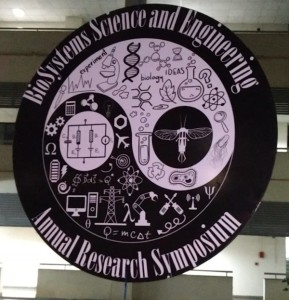
(Courtesy: BSSE)
The Centre for Biosystems Science and Engineering (BSSE) organized its annual research symposium from 8-9 January, 2016. The symposium whose theme was Cell, Tissue and Systems Engineering began with the Sanjay Biswas Memorial Lecture delivered by Nicholas Spencer (Professor, ETH-Zurich).
The symposium served as a platform to showcase the research being done at IISc as well as other institutes. The entire event was managed and organized by the students, GK Ananthasuresh, Co-Chair, BSSE, told CONNECT.
“We are happy that through this event, our students have gained confidence and have learnt to use technology to conduct an event like this,” Ananthsuresh added. To make the format interesting, the Principal Investigator (PI) or the professor from each group first gave an overview of the on-going work in his or her laboratory, followed by presentations by the students about their research.
Megha Prakash
MCB75: From Molecules to Organisms
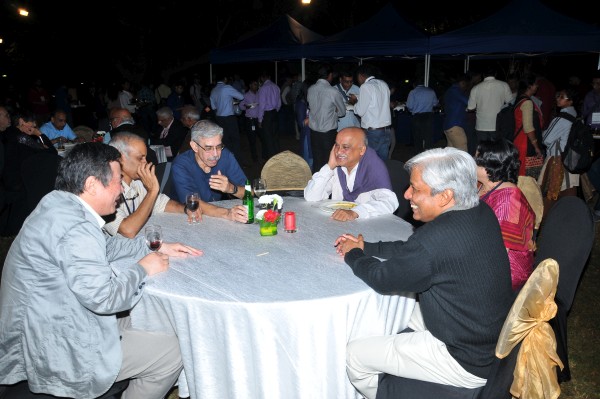
From left to right: Ichizo Kobayashi, J Gowrishankar, Imran Siddiqui, DN Rao, Deepti Deobagkar and K VijayRaghavan (Courtesy: Department of Microbiology and Cellular Biology)
The Department of Microbiology and Cell Biology (MCB) celebrated its 75th anniversary by organizing a symposium, MCB75: From Molecules to Organisms, from December 11-14, 2015.
Anurag Kumar, Director of IISc, inaugurated the event by presenting a brief history of the department which was founded in 1941 as the Pharmacology Unit. There were as many as 44 eminent researchers who spoke at the symposium, including Nobel laureates like Venki Ramakrishnan, MRC Laboratory of Molecular Biology, UK, and Richard J Roberts, New England Biolabs, USA. Both of them highlighted how recent technological advancements have made it possible to study basic aspects of biology.
Ujjini Manjunatha, Novartis Institute for Tropical Diseases, Singapore, and Rajesh S Gokhale, Institute of Genomics and Integrative Biology, New Delhi, talked about the necessity of discovering novel drugs and drug targets for drug-resistant tuberculosis. Ashok Venkitaraman, MRC Cancer Unit, UK, pointed out that cancer research required a shift in focus from single proteins to the affected cellular processes. Ramesh V Sonti, Centre for Cellular and Molecular Biology, Hyderabad, discussed his group’s efforts in developing disease-resistant rice lines to prevent crop losses in Andhra Pradesh. The last session of the symposium featured talks by alumni of MCB, Raman Sukumar and Raghavendra Gadagkar, both professors at the Centre for Ecological Sciences, IISc.
Students from IISc and other institutes had an opportunity to interact closely with scientists in their field of particularly during the poster sessions which saw a total of 144 posters being presented. A classical dance performance by students from the Dhrishti Art Centre added charm to the event., which, as Umesh Varshney, Chairperson, MCB said that the 75th anniversary celebrations of MCB was “the beginning of the platinum jubilee celebrations.”
Akanksha Dixit and Sakshi Gera
Conference On Neurodegenerative Diseases
The newly-founded Centre for Brain Research (CBR) at IISc organized its first international conference from 16–18 November, 2015, on Neurodegenerative Diseases: Pathogenesis to Therapy. Leading researchers from all over the world gathered to deliberate on the challenges and recent advances in diseases related to the ageing brain.
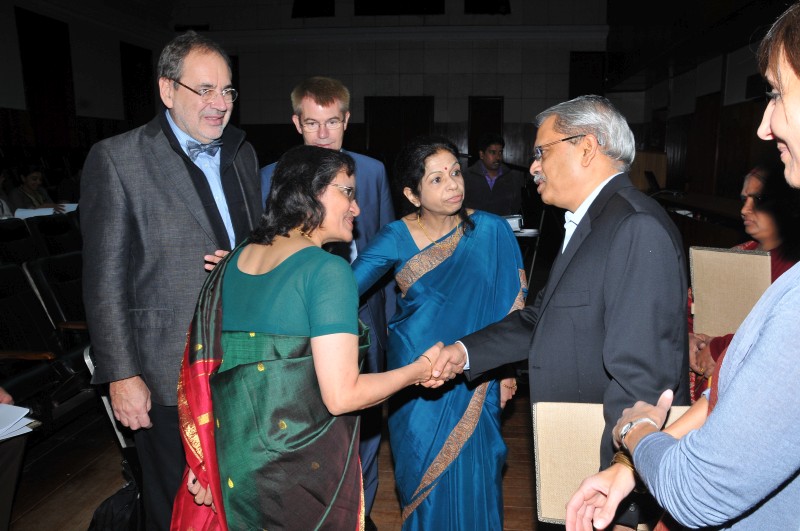
Left to Right: Yves Joanette, Sudha Seshadri, Hirsch Etienne, Vijayalakshmi Ravindranath, Kris Gopalakrishnan, Ana Ines Ansaldo (Courtesy: Public Relations Office)
“Relentless ageing of the society and imperfect diagnosis is making Alzheimer’s disease a world health epidemic,” warned John C. Morris (Professor, Washington University at St. Louis) in his talk. He went on to describe the central problem: the brain is usually irreparably damaged by the onset of the behavioral symptoms, rendering clinical intervention futile. Other talks stressed the need for a more systematic, focused and collaborative effort to deepen our understanding of neurodegenerative diseases and mitigate their symptoms. Researchers also presented novel population-level epidemiology studies and computational approaches for early diagnosis apart from discussing the recent successes in the field. Many speakers also highlighted the need for research in detecting and treating another form of dementia seen in some people suffering from Parkinson’s disease.
Researchers from IISc including Deepak Nair and Balaji Jayaprakash (both Assistant Professors, Centre for Neuroscience) showcased the recently set up ultra-resolution microscopy and in-vivo live neuron cell imaging facilities at IISc. Vijayalakshmi Ravindranath (Chairperson, Centre for Neuroscience) also presented very promising data showing that traditional Indian herb extracts reduced Alzheimer’s symptoms in animal models of the disease.
The conference concluded with a panel discussion on the importance of creating a “Dementia Network” – a common platform for caregivers, researchers and doctors. Chairing the panel, Stanley Fahn (Columbia University) stressed on increasing communication between all members of this network. Yves Joanette (Université de Montréal) added that it was important for academia and industry to collaborate. Y Narahari (Professor, Department of Computer Science and Automation, IISc) underscored the role of big data analytics and cloud based data-sharing among members. Echoing the views of the panel, Ravindranath, in her concluding remarks, indicated that CBR would create a web portal to connect people working in the field of dementia.
The Centre was founded earlier this year with a generous grant from the Pratiksha Trust, established by Kris Gopalakrishnan (co-founder of Infosys) and his wife, Sudha Gopalakrishnan. Explaining the motivation behind setting up the Centre, Kris Gopalakrishnan said, “In the next 10 years, the population above the age of 65 in India will go up dramatically and it is estimated that one out of every five individuals will suffer from brain-related disorders.” Speaking to CONNECT, he also said that he would like to see IISc, and hence Bangalore, become the hub for brain research. He added, “This conference is just one of the many more to come in future.”
Sudhi Oberoi
Higher Education: What’s The Way Forward?
A Discussion Meeting on New Knowledge was organized by the Centre for Contemporary Studies (CCS), IISc, on 3 October, 2015 to discuss the challenges facing the higher education system in India and the steps to overcome them.
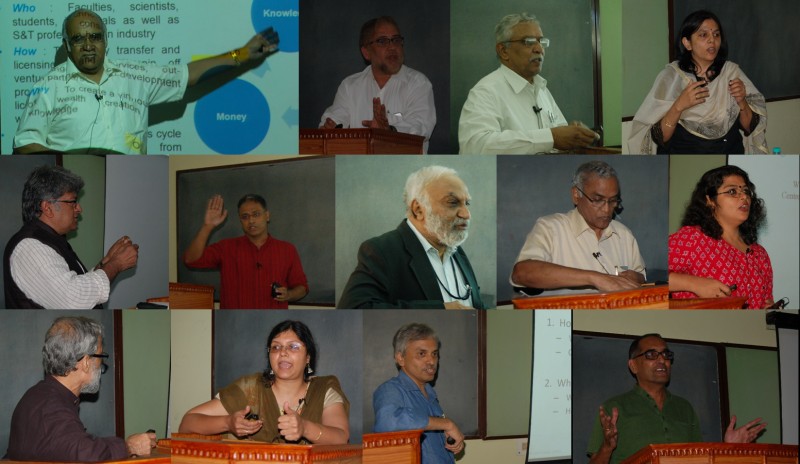
Row-wise (L to R): S. Sivaram, Raghavendra Gadagkar, HA Ranganath, Maulishree Agrahari, Vijay Chandru, Suri Venkatachalam, Parameshwar Iyer, NJ Rao, Anindita Bhadra, Rajan Gurukkal, Harini Nagendra, Rudra Pratap, Uday Balakrishnan (Courtesy: CCS)
One of the major challenges is bureaucratic interference, said Rudra Pratap (Chairman and Professor, Centre for Nano Science and Engineering, IISc). He remarked that the education system in Finland is a success because it lends greater autonomy to teachers at the university level. To help improve the state of institutes of higher education in India, Suri Venkatachalam (Connexions Life Science, Bangalore) suggested that increased funding was essential. However, S. Sivaram (Director, National Chemical Laboratories, Pune) opined that government funding alone would not fuel innovation.
Improving Curriculum Content
Rajan Gurukkal (CCS) said that academics should map new knowledge which is interdisciplinary and regenerative in nature, and which helps us understand problems of national interest. Agreeing with Gurukkal, Harini Nagendra (Azim Premji University) added that new knowledge is complex, and that it changes rapidly. In order to integrate and contextualize such new knowledge, Venkatachalam and Anindita Bhadra (Assistant Professor, IISER Kolkata) stressed on the need for including liberal arts and humanities courses in science institutes.
In addition to upgrading the curricula, most of the speakers agreed on widening the scope for hands-on training in the learning process. Highlighting a Karnataka government initiative called “Catch them young”, Maulishree Agrahari (Directorate of IT & BT, Bangalore) explained how it helped impoverished school children participate in science experiments designed to spark their interest.
Assessment
After curriculum design and teaching, assessment is the next step. NJ Rao (Former Chairman, Department of Electronics Systems Engineering, IISc) said that evaluators tend to focus on a few specific keywords in the students’ answer sheets, which assumes that what is not examinable is not worth teaching. H. A. Ranganath (Visiting Professor, Division of Biological Sciences, IISc) argued that the final grades given should be transferable between different universities and countries.
Industry Interaction
Addressing ways to enhance academia-industry interaction, S. Sivaram invoked legislations in the USA and Germany that helped universities reap financial benefits by letting them hold — and then lease for a fee — the Intellectual Property Rights for inventions made by their researchers. In addition to interaction with the industry, Nagendra expressed the need to encourage academic interaction with the civil society as well, for overall growth of the students.
Based on the discussion, the organizers proposed to prepare a policy document and submit it to the Ministry of Human Resources Development.
Raghunath Joshi
Smart Energy Systems
A mini symposium on Smart Energy Systems was organized by the Robert Bosch Centre for Cyber Physical Systems (RBCCPS) at IISc, on 16 September 2015.
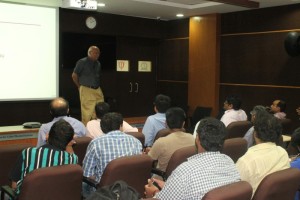
Participants during the symposium (Courtesy: RBCCPS)
The symposium sought to bring together researchers and students working in the field of energy systems and served as a platform for them to disseminate recent advancements in research and technology.
During the symposium, Shiv Kalyanaraman (Program Director, Special initiatives, IBM Research India) introduced the “nPlug”, a device that could help reduce the imbalance in the power loads in urban India, alleviating the problem of power cuts to a large extent. “By identifying power load peaks the nPlug helps distribute the power load evenly,” he said. He also spoke about Project UrJar, which envisages recycling discarded laptop batteries and using them to power small table lamps. This technology, he said, is being made available at low prices.
Rahul Tongia (Professor, Carnegie Mellon University) spoke about how smart grids, introduced in India in 2010, can help cut load shedding, detect power theft and also improve the service quality. Nagendra Rao (Department of Electrical Engineering, IISc) and Kumar PR (IISc) in their talks highlighted the challenges faced in integrating renewable energy sources with the grid system.
IWSDA’15
The Seventh International Workshop on Signal Design and its Applications in Communications (IWSDA’15) was organized from 13–18 September 2015 at IISc.
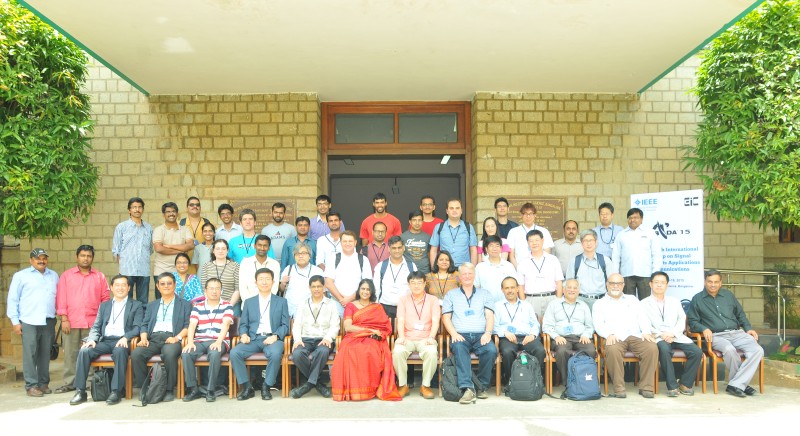
Participants at IWSDA’15 (Courtesy: Public Relations Office)
The biannual workshop was jointly organized by the Department of Electrical Communication Engineering (ECE) and the National Mathematics Initiative (NMI), and was co-sponsored by the Bengaluru Chapter of the Institute of Electrical and Electronics Engineers (IEEE). The workshop series originated in 2001 in Chengdu, China, and was held in India for the first time.
The weeklong workshop covered a wide range of topics such as signal design for CDMA, error-correcting codes, cryptography and big data analytics. There were also keynote and invited talks and poster sessions, broadly on low-correlation sequences and coding theory.
A special session was organized to celebrate the 60th birthday of P Vijay Kumar (Professor, ECE), a pioneer in the field of signal design. He has made seminal contributions to 3G Wideband Code Division Multiple Access (WCDMA), a technology that enhances the data transfer rate, which is ubiquitous in mobile telecommunication networks.
He was also one of the organizers of the workshop, which, he said, “provided a common discussion platform for pseudorandom sequence designers, coding theorists, cryptographers, communication practitioners and mathematicians.”
Sudhi Oberoi
6th Edition Of The Students’ Conference On Conservation Science (SCCS)
The sixth edition of SCCS, as in previous years, was held at IISc, from 8–11 September, 2015. It was organized by the Centre for Ecological Sciences (CES) at IISc, the National Centre for Biological Sciences (NCBS), the Ashoka Trust for Research in Ecology and the Environment (ATREE) along with the Madras Crocodile Bank Trust (MCBT) in Chennai and the Asian Nature Conservation Foundation (ANCF) in Mysore.
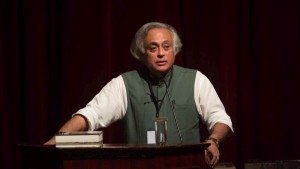
Jairam Ramesh, the former Union Minister for Environment and Forests (Courtesy: SCCS)
Around 500 participants from over 11 countries came together to share ideas and learn new skills during the event which included talks by experts, workshops, student presentations and posters. The focus of this year’s conference was on conservation work being done in Asia and Africa.
The event started with a plenary talk by TR Shankar Raman of the Nature Conservation Foundation, who talked about his work on ecological restoration. This was followed by a session with Ben Mirin, a beat boxer and avid birder, who combined vocal percussions with bird calls to produce some splendid music. In his plenary talk on day two, James D. Nichols, who has been a scientist with the U.S. Fish and Wildlife Service for more than 40 years and a long-time collaborator on Indian conservation research projects, spoke about how to make science more useful for conservation.
The plenary on day three by Sudha Vasan (Delhi University) illustrated the extent of globalization across India using the example of villages in the Kullu district where agriculture has shifted from traditional food crops to cash crops. Uma Ramakrishnan (NCBS) spoke about how advancements in genetics have aided conservation during her plenary talk on the final day of SCCS.
Different Conference Format
The first day of the conference focused entirely on long workshops, which ran for six hours each. Other days included shorter workshops every afternoon, imparting a variety of skills required for conservation. There were “Who’s Who in Conservation” sessions to introduce people to the work done by various research institutions and conservation organizations.
Every evening during the four-day conference, the JN Tata Auditorium, IISc hosted a talk which was free and open to the general public. Krushnamegh Kunte from NCBS spoke about retaining a sense of wonder for nature, and his passion for butterflies. Kanchi Kohli, a researcher and activist, detailed the conflicting aims of development and environmental management, and finally, Jairam Ramesh, former Union Minister of Environment and Forests, discussed climate change and Indian policies.
Students gave short presentations on a variety of topics, and from among them, the ones by Grace Nugi from Papua New Guinea, Rachakonda Sreekar from India and Rodrigue Castro Gbedomon from Benin were adjudged as the three best talks of the conference.
Ananya Jana and Shakilur Kabir
(With inputs from Gubbi labs and Madhura Amdekar)
Monsoon School On Urban Floods 2015
The second edition of the Monsoon School on Urban Floods was organized by the Department of Civil Engineering at IISc from 24–29 August, 2015.
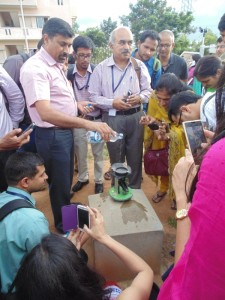
Participants during a live demonstration held as part of the school (Courtesy: Srivani Acharya)
Last year, the school began as an outreach activity as part of the research project entitled “Urban Flood Management in India: Technology Driven Solutions”, sponsored by ITRA (Information Technology Research Academy), Ministry of Information and Technology, Government of India. Lack of trained manpower and the miniscule number of experts available in the country led PP Mujumdar, Professor, Civil Engineering, to take the initiative for the school.
The key feature of the week-long school was its interactive nature. Participants were divided into small groups and were assigned problems related to urban flooding and water policies, among several others. The groups were encouraged to present their ideas for solving the assigned problem. This exercise was followed by a computer tutorial on how to use software to analyze problems of flooding in cities.
Apart from tutorials, group discussions and expert lectures on topics like urban meteorology, urban hydrology, radar and remote sensing analysis of rain events, big data analysis for urban processes, engineering practices and post-flood responses, were also held. A visit to the Karnataka State Disaster Management Centre (KSDMC) and the Hydraulics lab in IISc was also arranged. The KSDMC is a government organization which monitors floods in the city and was one of the partners of this school.
“It was a good exposure for the participants to know what measures the government is taking to combat urban flooding,” said Mujumdar. “It is good to see that MS Baroda University has now started working on urban floods after some of their faculty members attended the school last year. And enthused by both the content and structure of the programme, RK Dave, Head, Government Initiatives, ITRA has requested us to conduct the next edition in Nepal.”
Given the success of the programme, the only difficulty that the organizers had to deal with was accommodating the large number of participants. There were 47 participants this year, compared to last year’s 30, a mix of government officials, young faculty members, researchers and people from the industry. “Selection of the candidates was tough as we got large number of applications. We tried our best to have a fair representation of gender, geographical locations, and of different educational backgrounds,” the organizers said.
Megha Prakash











































